- (Click Here) CAT jetliner crash at Linkou, February 16, 1968.
- (Click Here) Filming of the movie "The Sand Pebbles" with Steve McQueen 1965 to 1966..
- (Click Here) Operations Building, Barracks Dormitories, and Supply Warehouse construction projects, 1962 to 1966.
- (Click Here) Linkou's 10th Anniversary Celebration in 1965 with shots of "Miss Shulinkou" and contestants.
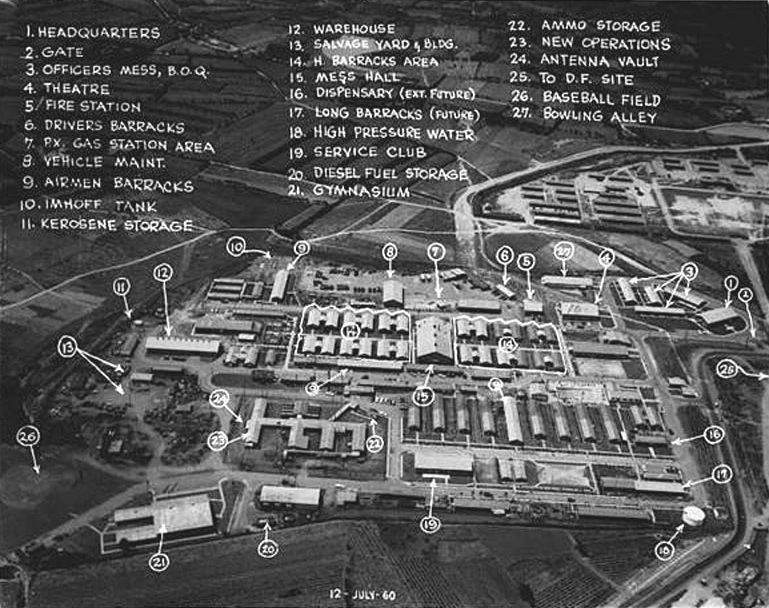
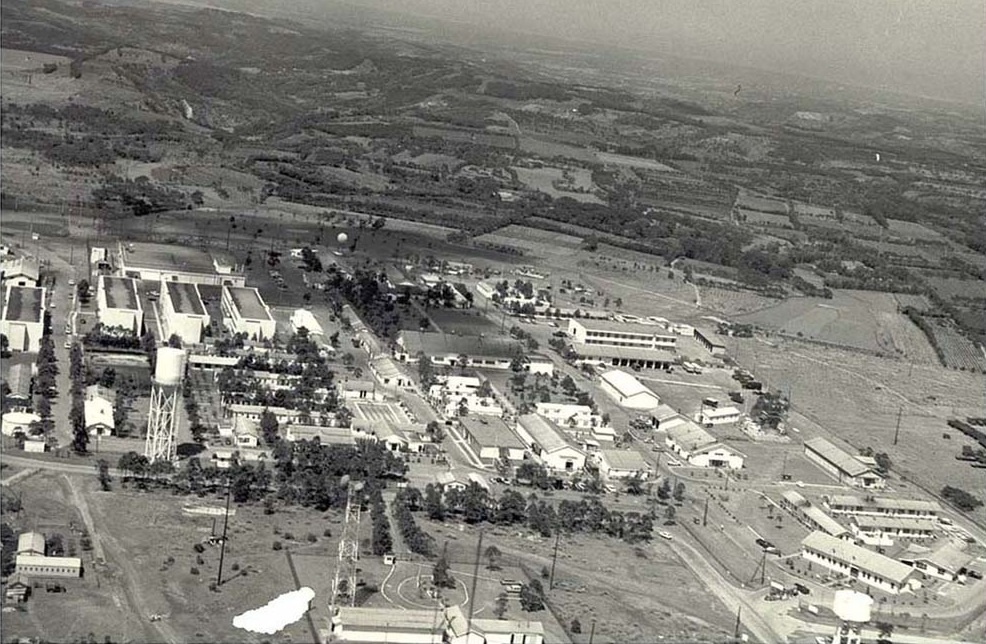
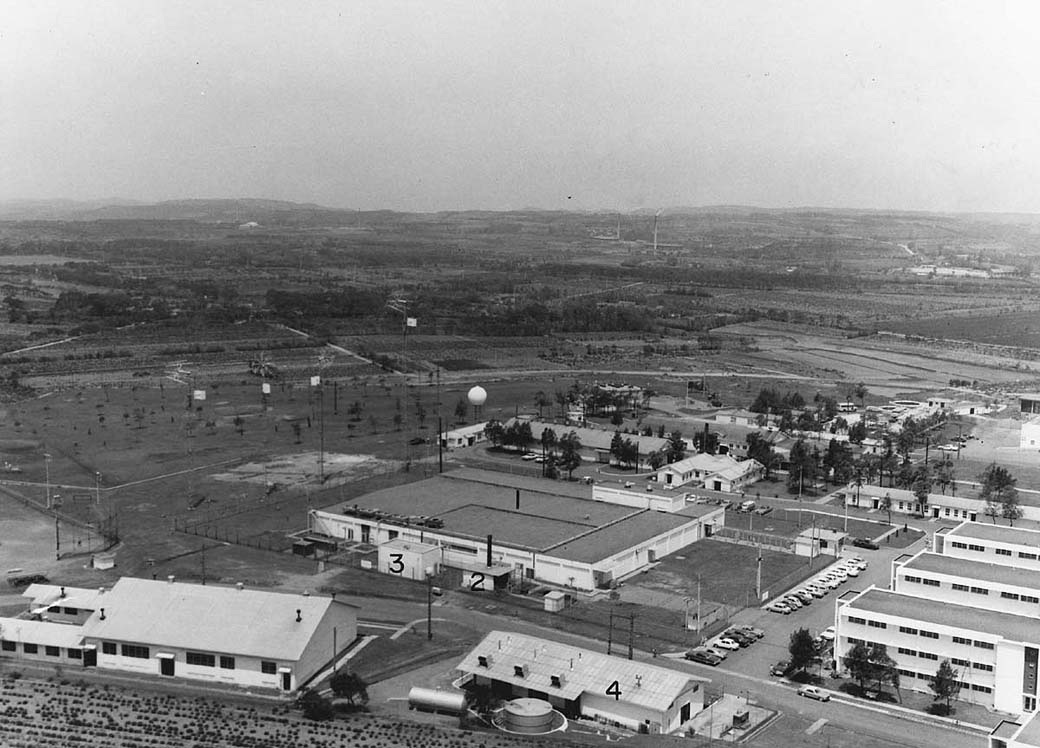
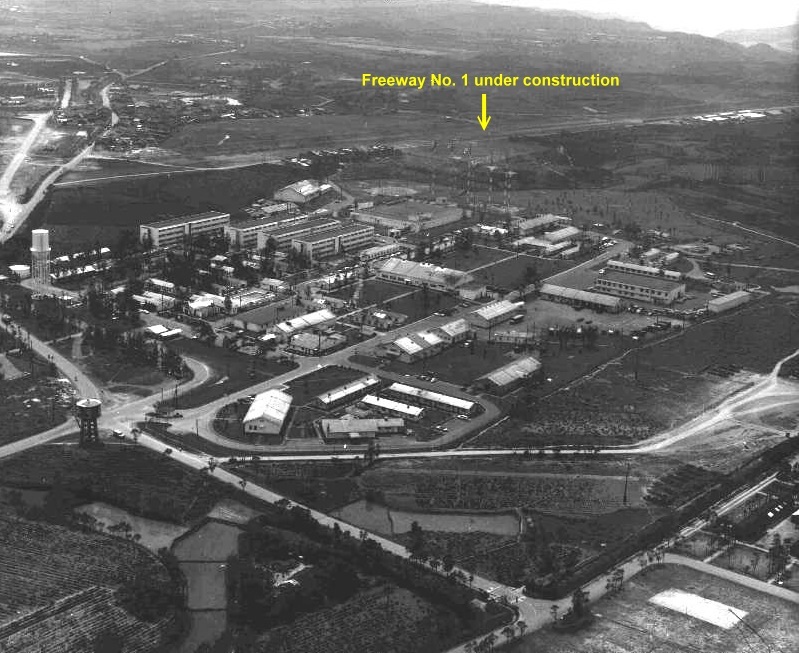

(Click on Images to Enlarge)
(1.) July 12, 1960 Aerial Photo-Above. Shown are the old barracks, Service Club, old Ops Building, both Main Gates (far right), and ROC Army barracks (upper right).
(2.) 1967 Aerial Photo. The new Dispensary is shown next to the Linkou Club. The "DF" site for the Operations Center is in the foreground.
(3.) Circa 1969 Aerial Photo. New Operations Building ("1") and Compound ("2" is the incinerator). "4" is the base Power Plant adjacent to the Gymnasium (foreground-far left).
(4.) Circa 1970 Aerial Photo. Shown are the completed 1960s construction projects throughout the modernized base.
(5.) Circa 1974 Base Map/Diagram. The base facilities shown on this 1974 diagram are unchanged from the 1969/70 timeframe.
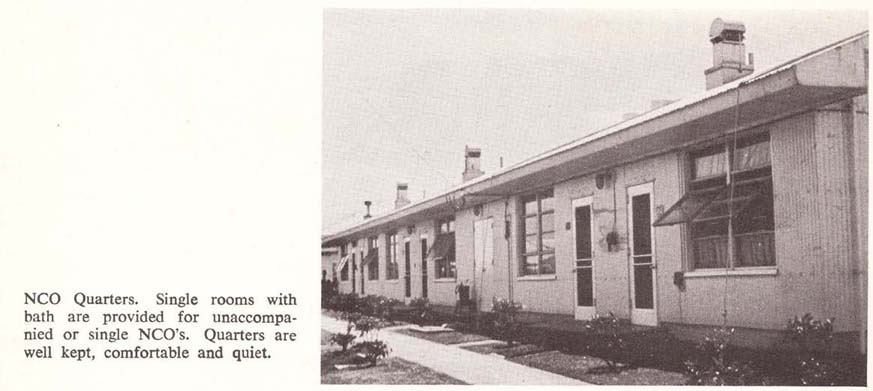
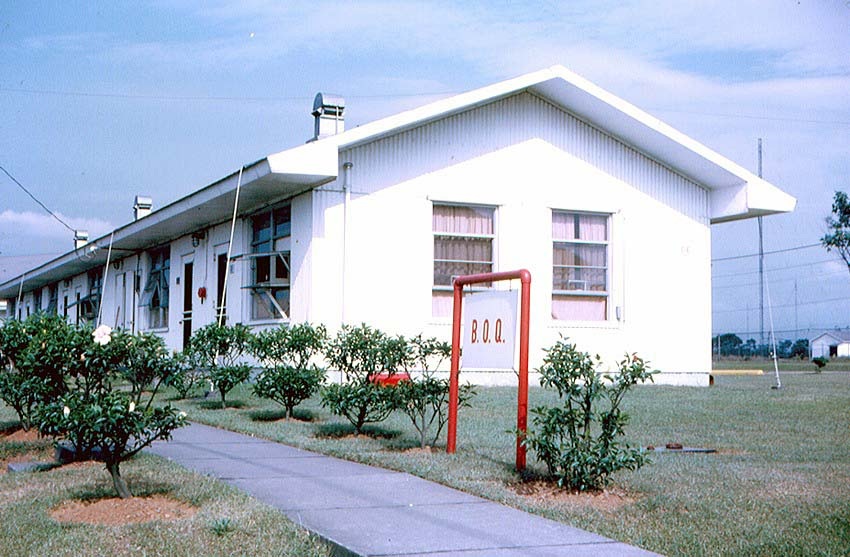 NOTE: Corrections and additions to the annotations in the 1960 aerial photo (no. 2.) above: Bill Martin ('63-'67, '70-'75): "The large building, number 9. is the "open-bay" NCO Barracks. The NCO Club/Lounge (E-5 and above) is the building just to the left of the open-bay NCO barracks. The three buildings in a row facing the NCO Club are NCO Barracks with six to eight rooms each with the latrine at the end of the barracks. The barracks' entrance was at the end of the barracks facing the NCO Club. Across the street from the NCO Club and barracks was the Wood Hobby Shop. In 1965 there weren't many officers living on base, so some of the NCOs were moved into a couple rooms in the Bachelor Officers' Quarters (BOQ) (photo on left), two to a room with a bath and private entrance door, for about a year until the new barracks dormitories were completed in Nov 1966. Jack King, the NCO Club manager, was my roommate." Bill Martin [21 May 11]
NOTE: Corrections and additions to the annotations in the 1960 aerial photo (no. 2.) above: Bill Martin ('63-'67, '70-'75): "The large building, number 9. is the "open-bay" NCO Barracks. The NCO Club/Lounge (E-5 and above) is the building just to the left of the open-bay NCO barracks. The three buildings in a row facing the NCO Club are NCO Barracks with six to eight rooms each with the latrine at the end of the barracks. The barracks' entrance was at the end of the barracks facing the NCO Club. Across the street from the NCO Club and barracks was the Wood Hobby Shop. In 1965 there weren't many officers living on base, so some of the NCOs were moved into a couple rooms in the Bachelor Officers' Quarters (BOQ) (photo on left), two to a room with a bath and private entrance door, for about a year until the new barracks dormitories were completed in Nov 1966. Jack King, the NCO Club manager, was my roommate." Bill Martin [21 May 11]
(Left) BOQ, 1965 photo (also used as NCO quarters in 1965) Source: 1965 Taiwan Report (Right) BOQ, 1967 photo Unknown
Capt William D. Tortoriello (29 Nov 54-17 Apr 55), Maj High C. Dunn (18 Apr 55-10 Jan 56), Capt John J. W. O'Berg (11 Jan 56-Dec 56), Capt Harold N. Foster (Dec 56-08 Apr 57), Maj Robert F. Stark (09 Apr 57-Mar 59), Capt Leonard C. Hess (Mar 59-30 Jun 59), Col Glenn T. Stitt (1 Jul 59-14 Ju 60), LTC Morris B. Johnson (15 Jul 60-12 Jul 62), LTC Carlos J. Ricketson (13 Jul 62-18 Jul 62), LTC Joseph P. Byrne (19 Jul 62-23 Jun 64), Col Kenneth H. Powers (24 Jul 64-18 Aug 64), LTC Paul A. Fitzgerald (19 Aug 64-26 Dec 65), LTC George J. Alles (27 Dec 65-02 Jan 66), Col Raymond E. Lambert (03 Jan 66-29 Jun 67), Col Robert P. Craig (30 Jun 67-26 Jun 69), Col William B. Barnes (29 Jun 69-27 Jun 71), Col O. D. Graham (28 Jun 71-19 Jun 73), Col Donald E. Weaver (20 Jun 73-Sep 74). (Col Weaver was previously stationed at Linkou in 1957 as a captain.), and Col James E. Kater (1974/75-Mar 1977).
Source: "USAFSS, Command Historian, A Special Historical Study of the Organizational Development of United States Air Force Security Service: 1966-1970" and "USAFSS, Command Historian, A Historical Study of the Organizational Development of USAFSS: 1970-1974"
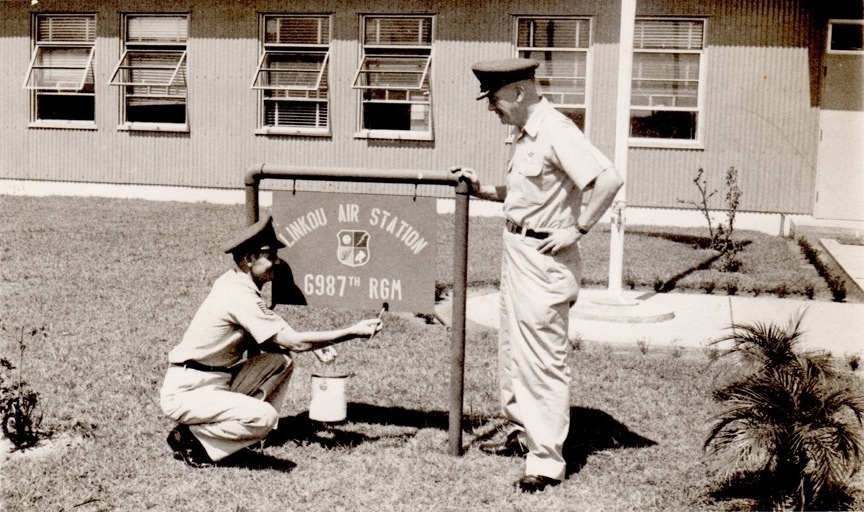
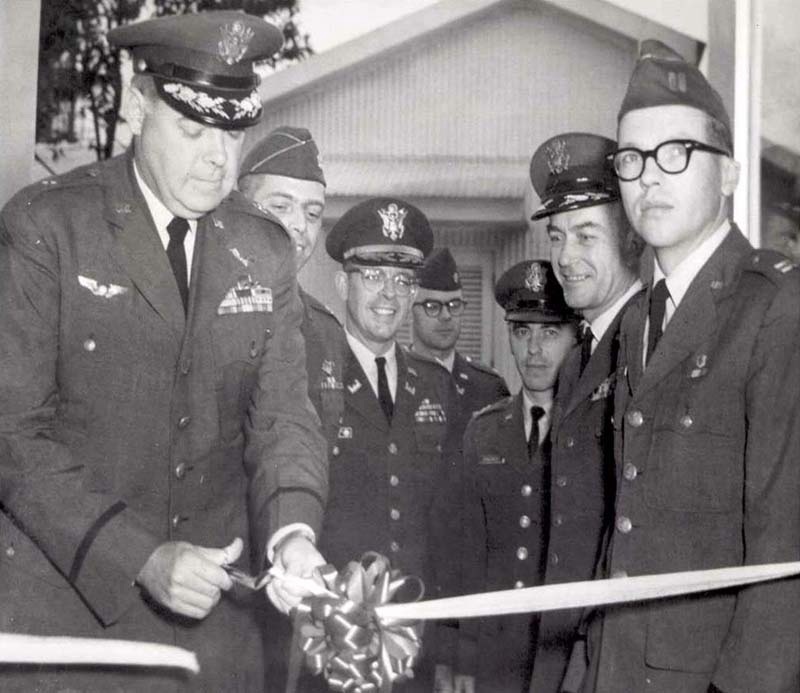
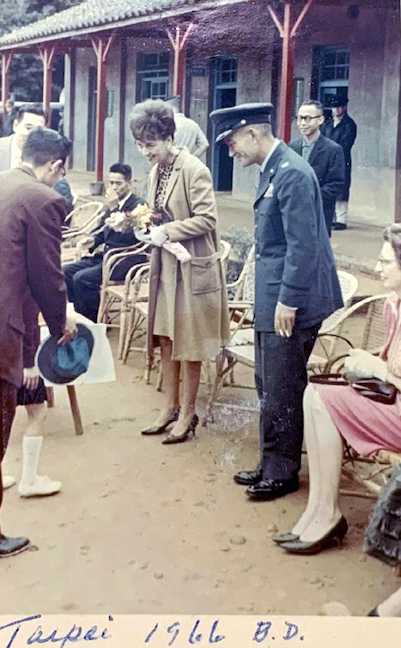
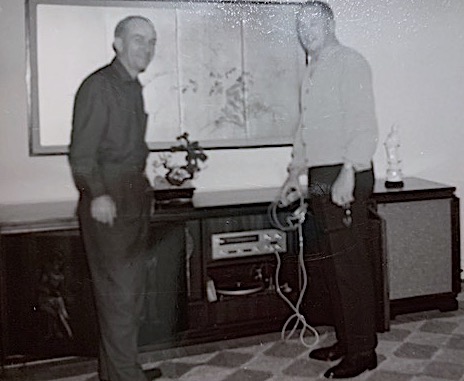
(1.) 1962/63 shot of Lt. Colonel Joseph P. Bryne, Linkou Base Commander 1962-1964, and the base First Sergeant (MSgt) at the new 6987th RGM (Radio Group Mobile) sign in front of Headquarters. Shulinkou was formerly designated the 6987th RSM (Radio Squadron Mobile).
(2.) January 24, 1967 ribbon cutting ceremony at the opening of the new SLK Dispensary built next to the Linkou Club. The only identified officer in the photo is Colonel Raymond E. Lambert, Shulinkou AS Base Commander (03 Jan 66 to 29 Jun 67). Colonel Lambert is second from the right (next to the captain wearing glasses).
(3.) 1966 shot of Colonel Robert E. Lambert, Shulinkou AS Base Commander 1966 to 1967, and his wife, Jeanne M. Lambert, being greeted by Taiwanese officials. Mrs. Lambert is holding a bouquet of flowers she received from a Taiwanese child at the gathering.
(4.) 1966 shot of Colonel Raymond E. Lambert (left), Shulinkou Base Commander 1966 to 1967, at his home in Taipei with another Shulinkou officer.
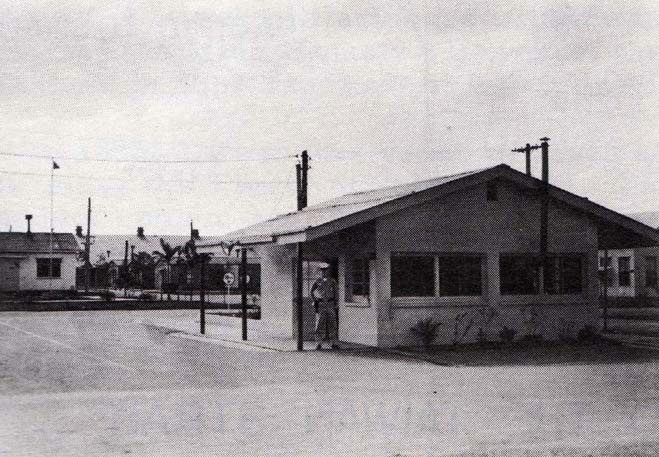
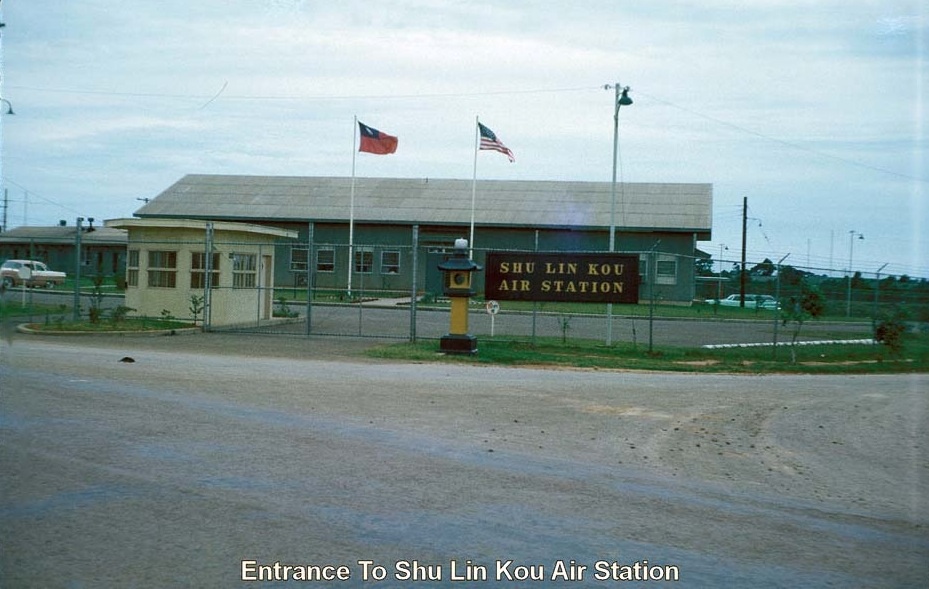
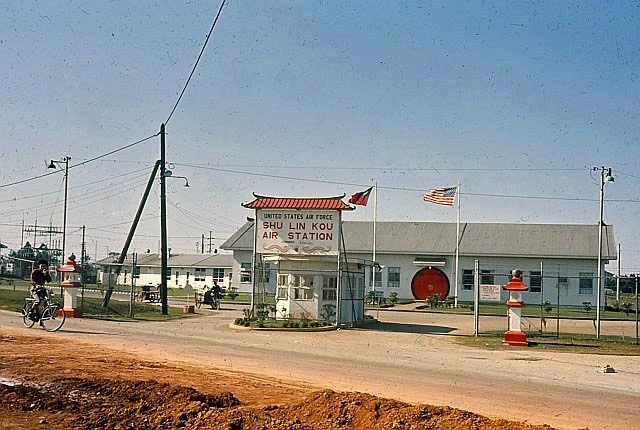
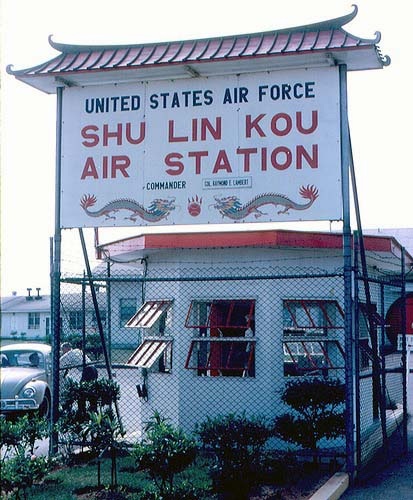
(Click on Photos to Enlarge)
"Around 1958 and 1959, a few construction monies began to trickle in and a few buildings, such as the Dining Hall, the Headquarters building, and Officers' Mess (Officers Club) were started. As time went on, then came the Base Exchange (BX), the Theater, the Bowling Alley, and the luxury of air conditioning." ( source: Shulinkou Devil Dog base newspaper, Feb. 23, 1977 edit.) provided by Roger Jarvis (SLK Sep '75 to 31 Mar '77)
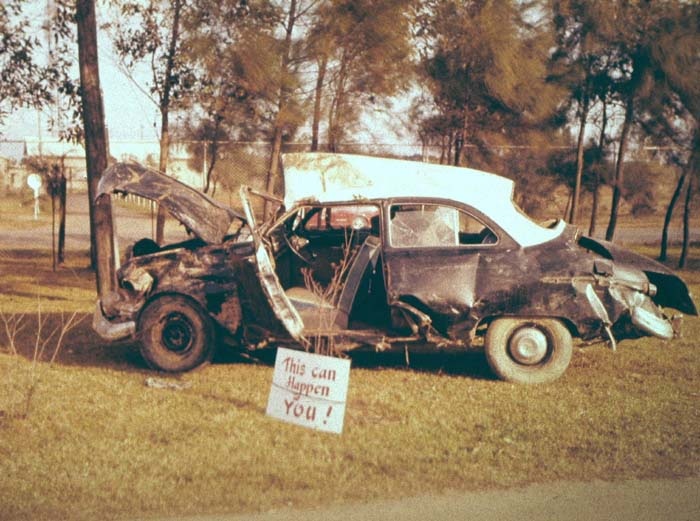
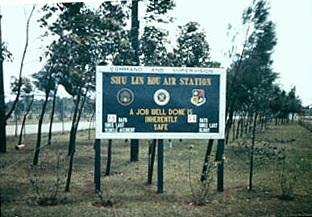 (1.) 1961/62 shot taken from outside of base of the centrally located, original Main Gate and Guard Shack, added in 1955. Visible in the background are the Chapel (far left), Dining Hall (large roof), Barracks (behind guard shack), and Linkou Club (far right).
(1.) 1961/62 shot taken from outside of base of the centrally located, original Main Gate and Guard Shack, added in 1955. Visible in the background are the Chapel (far left), Dining Hall (large roof), Barracks (behind guard shack), and Linkou Club (far right).
(2.) 1962/63 shot of the new Main Gate, Guard Shack, Headquarters building, and Bachelors' Officers Quarters (BOQ) (far left). This new gate was added in 1959 or 1960, and was utilized as the primary gate on base.
(3.) 1966 shot of the Main Gate, Headquarters, and BOQ (left).
(4.) 1967 shot of the Main Gate, Guard Shack, Headquarters (background), and BOQ (far left). Col. Raymond E. Lambert (name on guard shack sign) was base commander from January 1966 to June 1967.
(Photos on Right-Click to Enlarge) 1962 shots of the base vehicle safety sign and demolished car that went over the side of the winding mountain road from Linkou to Taipei. All four airmen aboard, who were rushing back to Linkou after partying in Taipei, miraculously survived the crash with only minor injuries. The car was on display right next to the safety sign, which was located across from the old Main Gate, just off to the left of the photo above (photo no. 1.). Both photos by Jim Bohn, courtesy of "6987thAlumniAssociation.org"
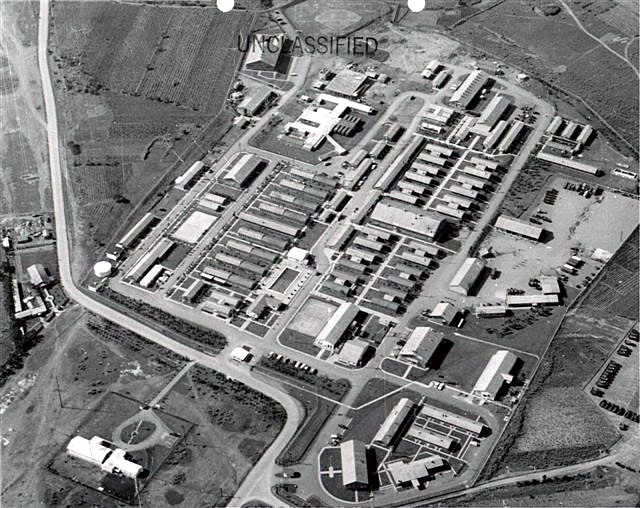
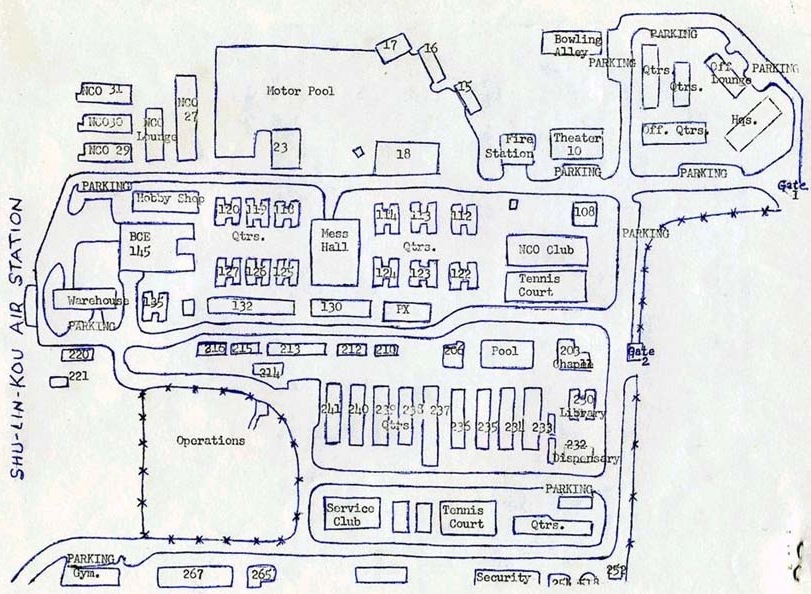 (Left & Right Images-Click to Enlarge) Both gates are shown in the 1963 Linkou aerial photo (left) and 1961 base map (right).
(Left & Right Images-Click to Enlarge) Both gates are shown in the 1963 Linkou aerial photo (left) and 1961 base map (right).
Credits: (Left) photo courtesy of K. Kovach (Right) map provided by G. Knighton courtesy of B. Atherton
NOTE: The old gate ("Gate 2" on map on right), was utilized by construction vehicles to keep their noise and dust away from Headquarters during construction of the new Operations Building, Dormitories, Supply Warehouse, and other new buildings during the mid-1960s (see construction photos below). The new gate ("Gate 1" on map on right) located near Headquarters became the "official" primary gate during this new construction period on base.

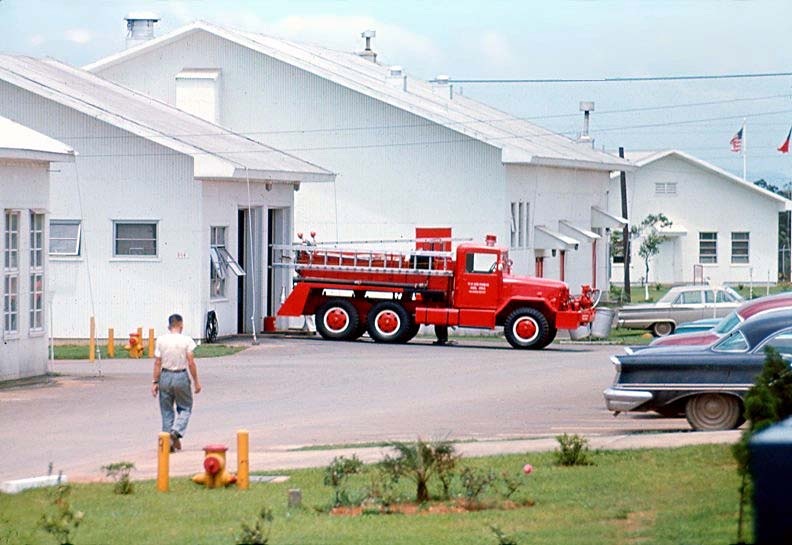
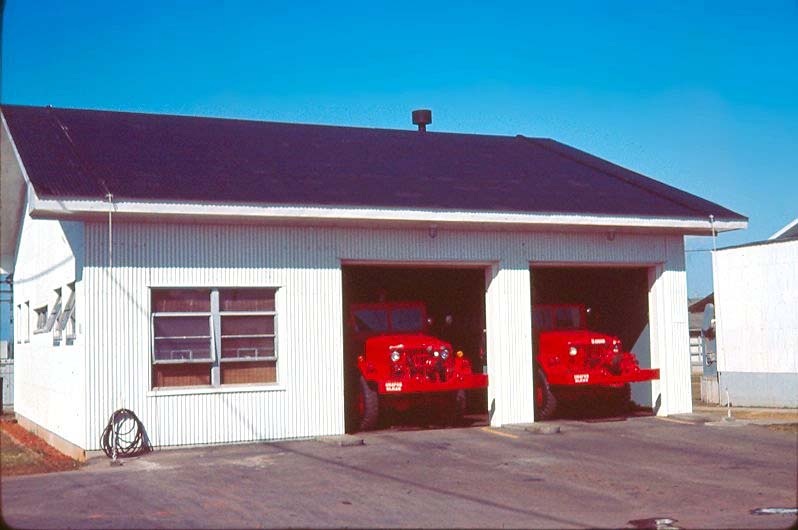
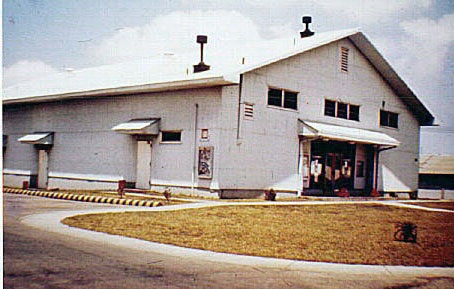
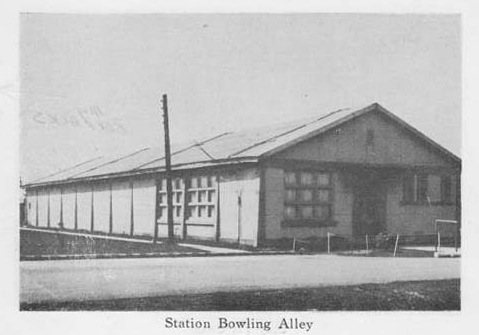
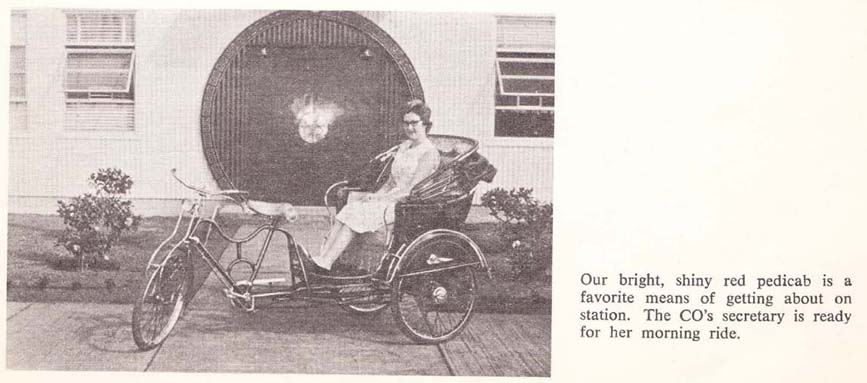
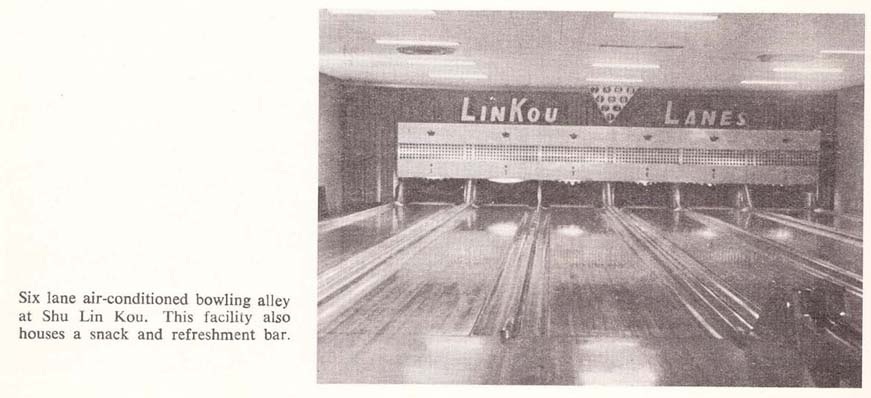 (1.) 1966 shot of the Headquarters building. The BOQ (see photo above) was off to the left. (2.) 1966 shot of the (L-R): Motor Pool (far left), Fire Station, Theater, and Headquarters (far right) (3.) 1964 shot of the Fire Station (4.) 1967 shot of the base Movie Theater and "Linkou Lanes" Bowling Alley (far right-roof visible). The daily showing at the Theater was at 1900," Midnight Flicks" for shift workers were held three times weekly. (5.) Circa 1965 shot of the six Linkou Lanes Bowling Alley located next to the Theater.
(1.) 1966 shot of the Headquarters building. The BOQ (see photo above) was off to the left. (2.) 1966 shot of the (L-R): Motor Pool (far left), Fire Station, Theater, and Headquarters (far right) (3.) 1964 shot of the Fire Station (4.) 1967 shot of the base Movie Theater and "Linkou Lanes" Bowling Alley (far right-roof visible). The daily showing at the Theater was at 1900," Midnight Flicks" for shift workers were held three times weekly. (5.) Circa 1965 shot of the six Linkou Lanes Bowling Alley located next to the Theater.
(Left Photo-Click to Enlarge) 1965 shot of the Linkou pedicab. (Photo on Right) Linkou Lanes Bowling Alley, 1965.
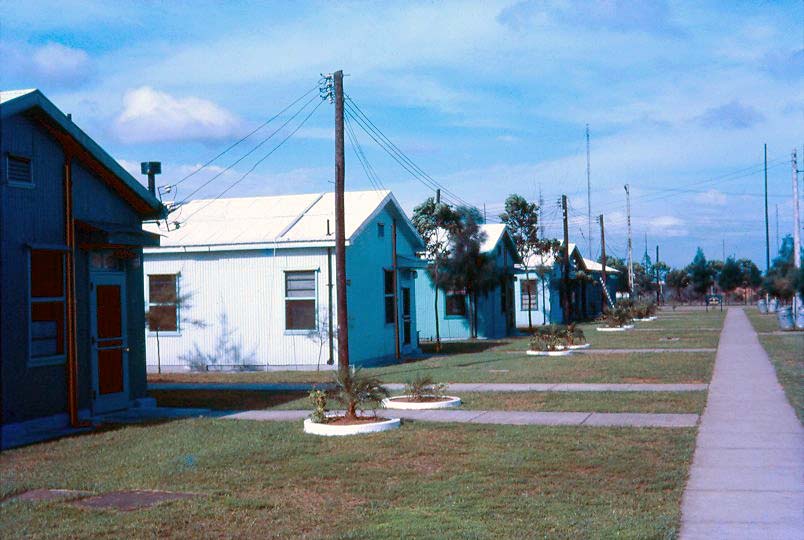
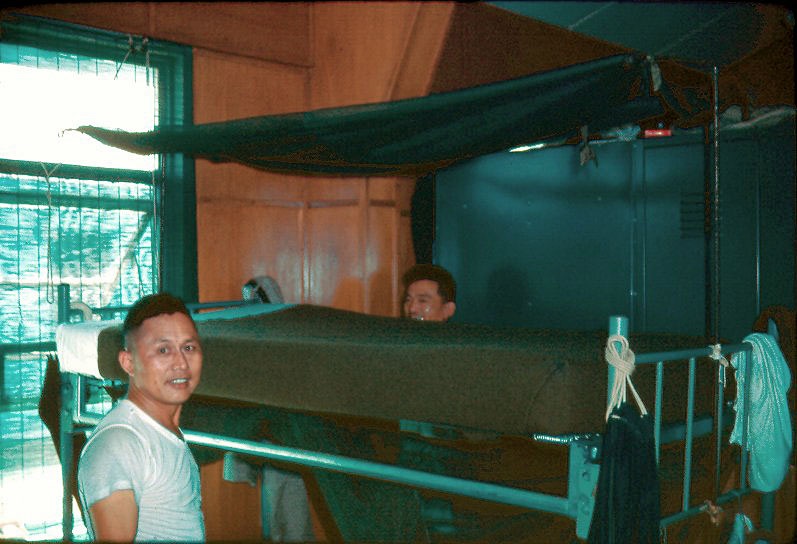
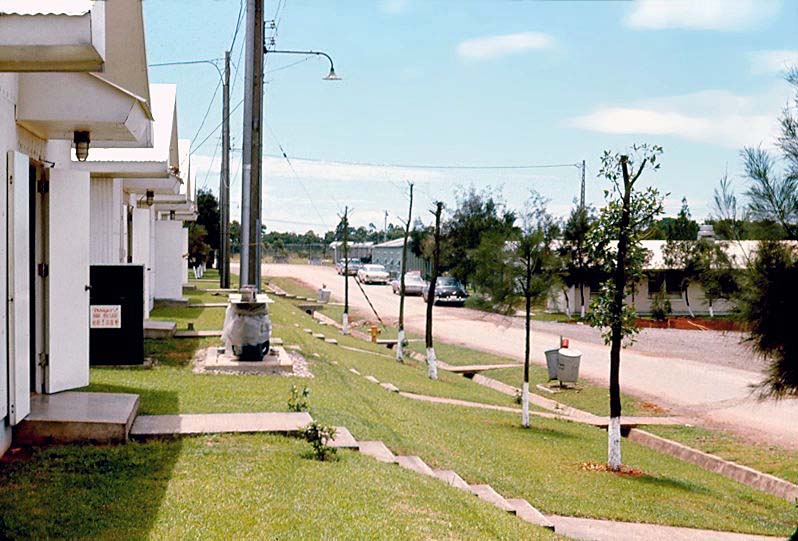
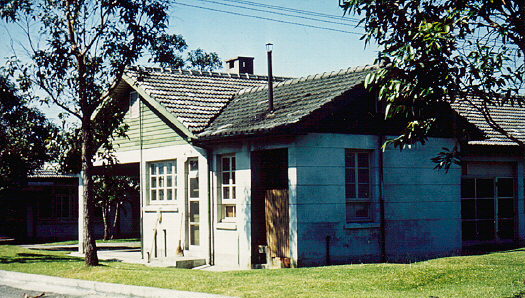
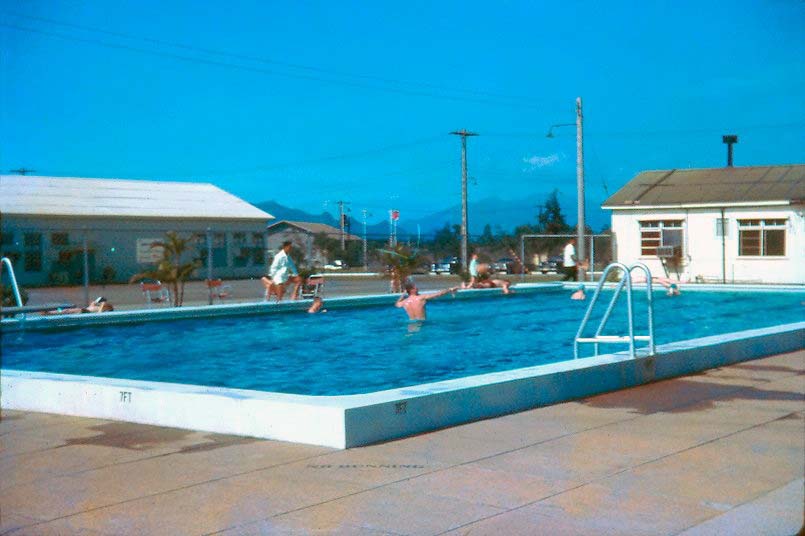
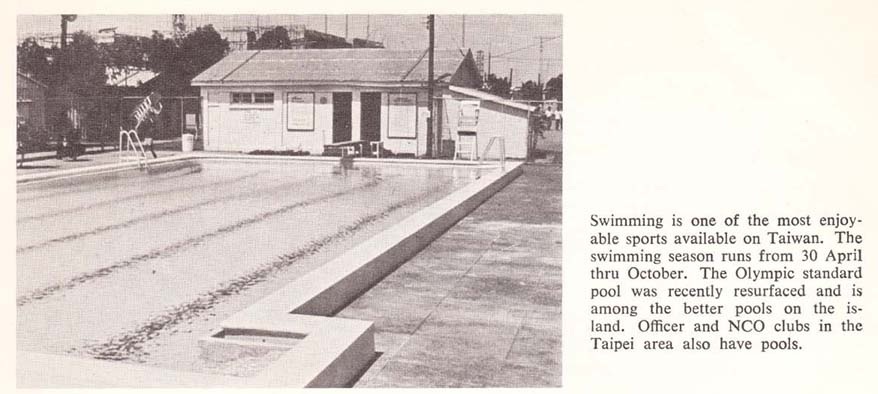
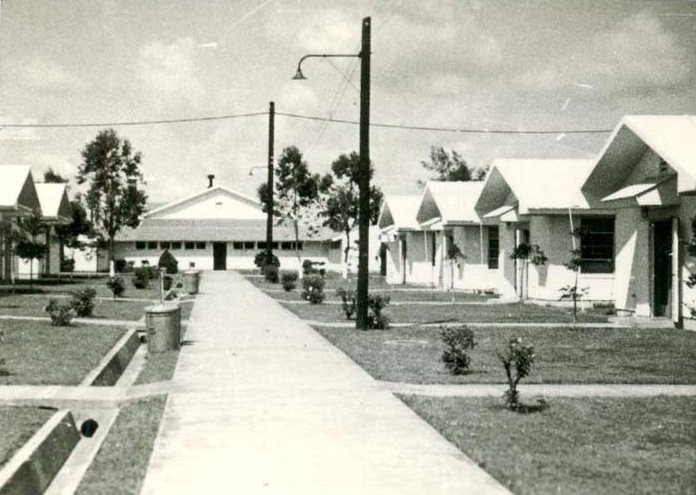 (1.) Corrugated metal open-bay barracks 1964/65. (2.) 1964 shot of Les Duffin's ('62-'66) two houseboys in his open-bay barracks. Note the mosquito netting above the bunk and the metal wall lockers. (3.) 1964/65 shot of the H-shaped open-bay barracks with the latrine located between both barracks. (4.) 1966 shot of the old Special Services building built in the late 1950s. (5.) 1963 shot of the swimming pool looking toward Headquarters (background-flags) and Main Gate. Also shown are the Linkou Club (left) and back of the Chapel (far right).
(1.) Corrugated metal open-bay barracks 1964/65. (2.) 1964 shot of Les Duffin's ('62-'66) two houseboys in his open-bay barracks. Note the mosquito netting above the bunk and the metal wall lockers. (3.) 1964/65 shot of the H-shaped open-bay barracks with the latrine located between both barracks. (4.) 1966 shot of the old Special Services building built in the late 1950s. (5.) 1963 shot of the swimming pool looking toward Headquarters (background-flags) and Main Gate. Also shown are the Linkou Club (left) and back of the Chapel (far right).
(Photo on Left-Click to Enlarge) H-Barracks Row and Chow Hall 1965. (Photo on Right) Shulinkou pool 1965.
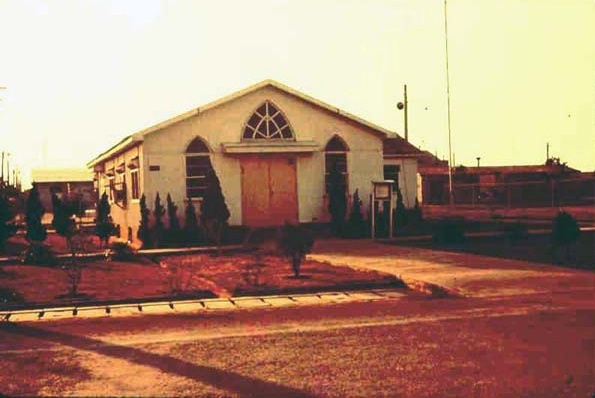
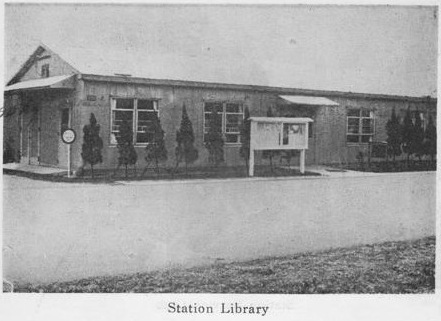
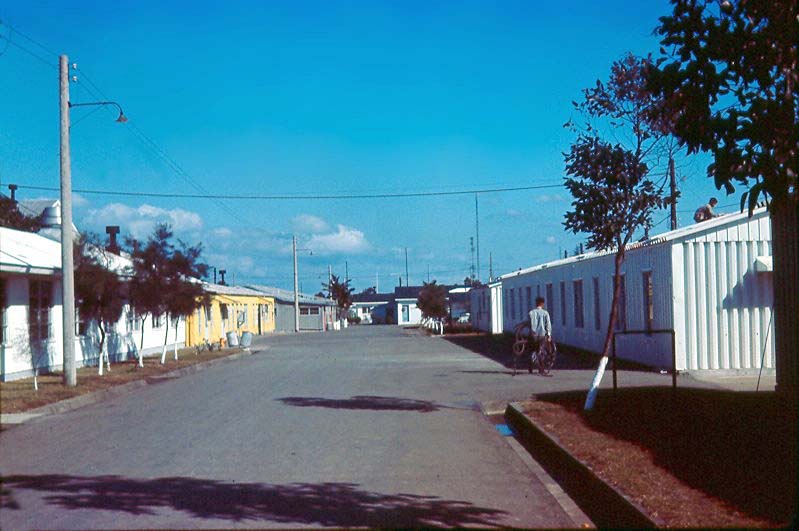
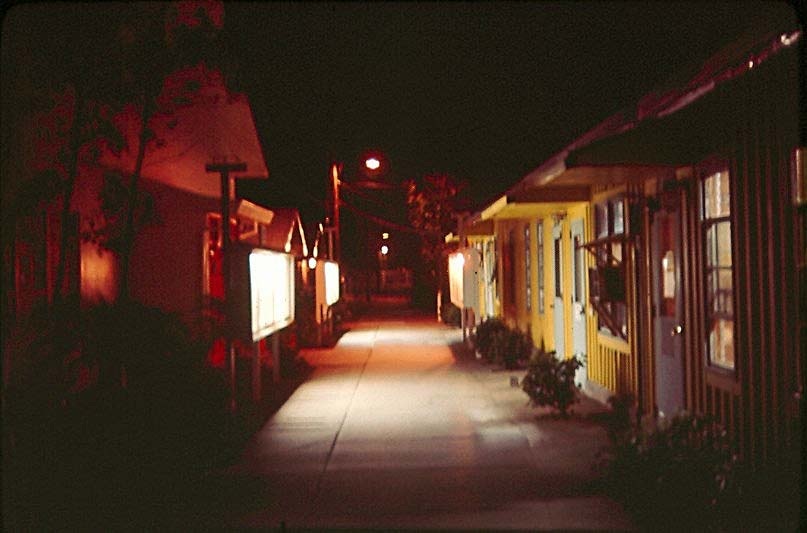
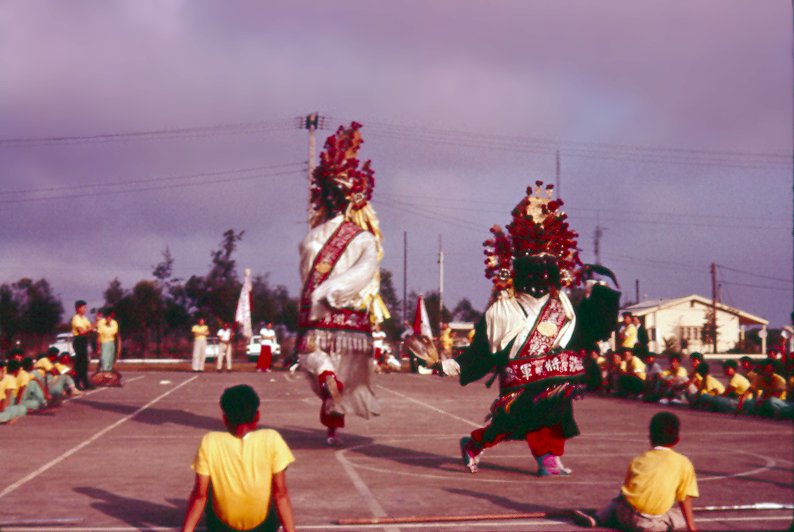
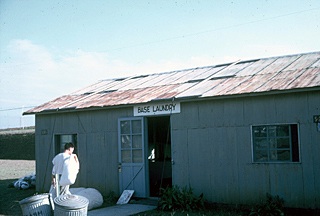
(Below left and right) "The Taiwan Report" (1965) provided by S. Ellinger
(Click on Photos to Enlarge)

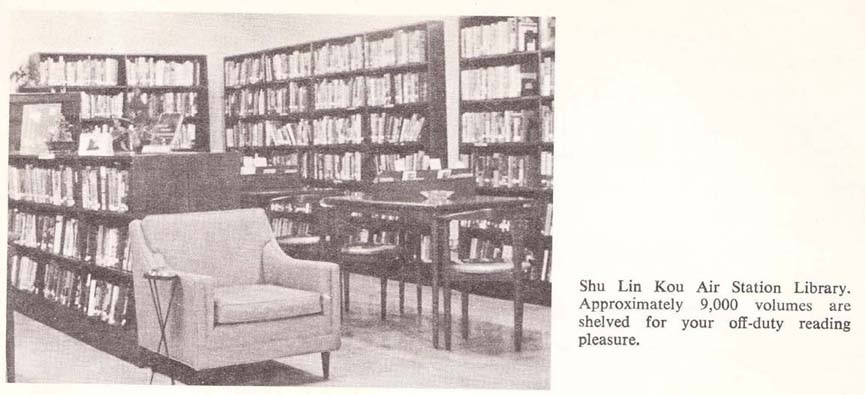 (1.-Above) 1961/62 shot of the Shulinkou Chapel located near the Linkou Club and right across the street from the original Main Gate. (Left Photo) Chapel 1965 with a changed facade from 1962.
(1.-Above) 1961/62 shot of the Shulinkou Chapel located near the Linkou Club and right across the street from the original Main Gate. (Left Photo) Chapel 1965 with a changed facade from 1962.
(2.) 1965 shot of the base Library located next door to the Chapel. (Right Photo) Library 1965.
(3.) 1964 view looking toward the Main Gate: Accounting & Finance (far right), Mail Room and Orderly Room (yellow bldg-left), old Base Exchange (grey bldg on left), Chow Hall (far left), Pool House (distance).
(4.) Chow Hall entrance (left), Bulletin Board (right), Mail Room (far right), Orderly Room (1963).
(5.) The Double Ten Day (10 Oct 63) festival celebration on the old Tennis and Basketball Court (site of the new Dispensary) next to the Linkou Club (off to left). Original Main Gate/Gate Shack in right background.
(6.) Base Laundry 1962/63.
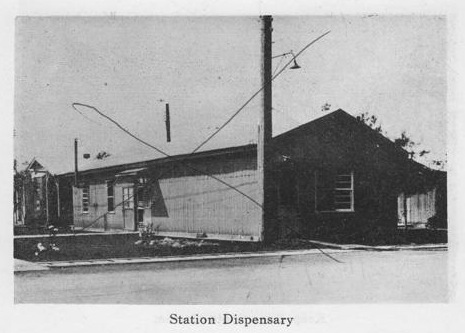
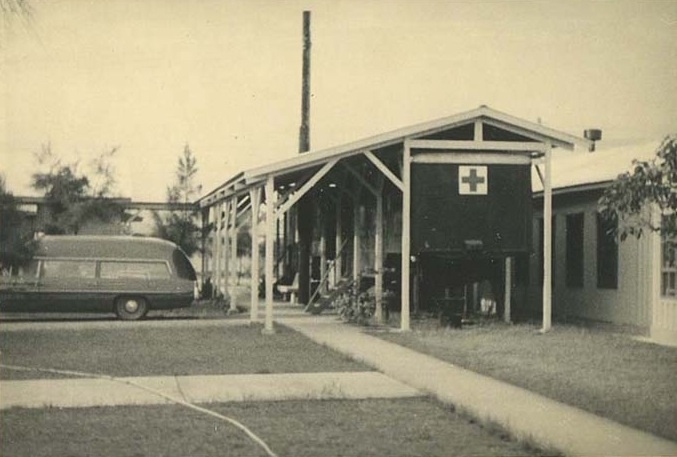
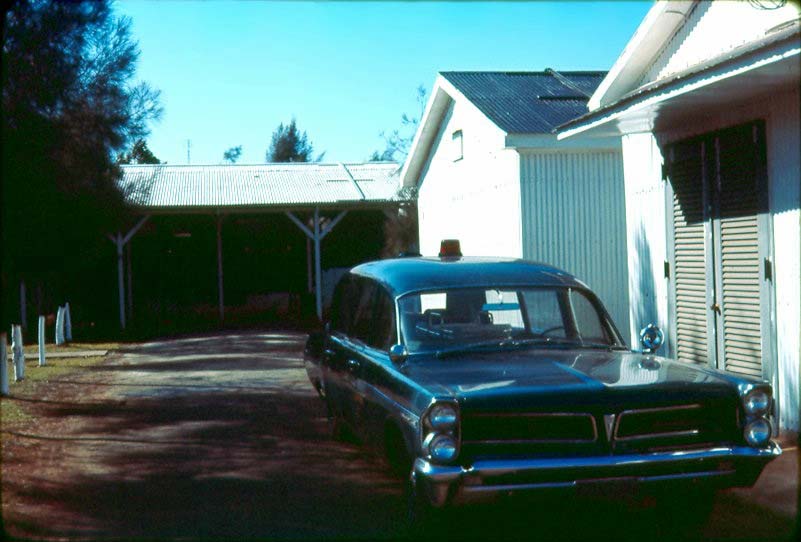

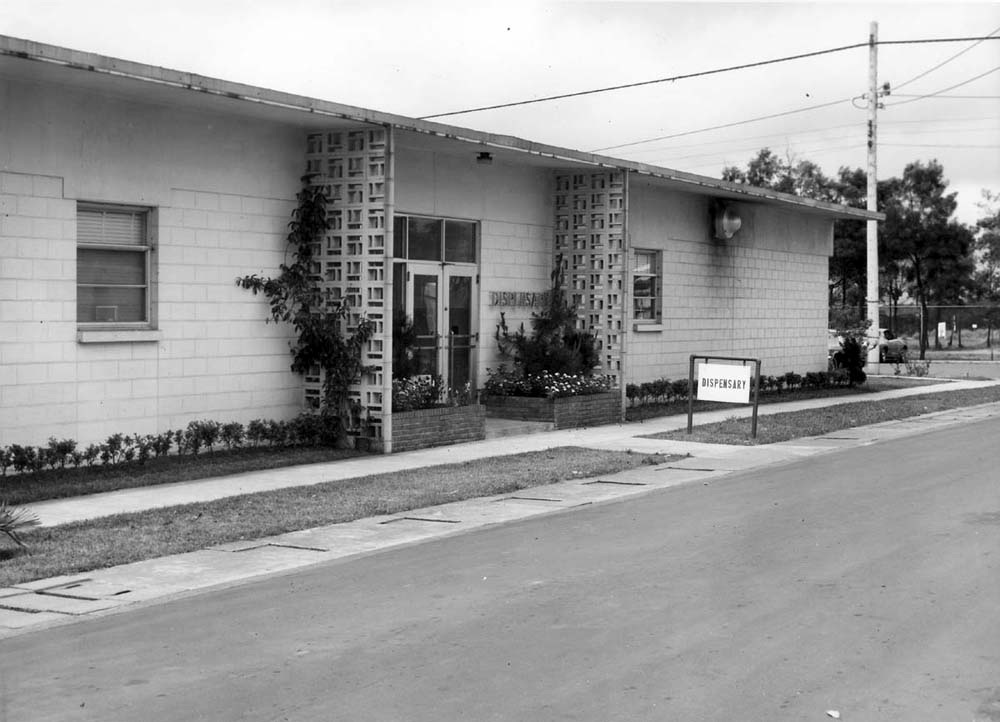
(4. & 5.) photos with permission and courtesy of USAF ISR Agency History Office
(Click on Photos to Enlarge)
(1.) The old corrugated metal Dispensary in 1965. It was later relocated next to the Linkou Club in a new concrete building (photo 5.) (2.) 1963 shot of the rear of the Dispensary showing a dental van (red cross) and the base ambulance. (3.) 1964 shot of the base ambulance parked behind the old corrugated metal Dispensary. (4.) January 24, 1967 ribbon cutting ceremony at the opening of the new Shulinkou Dispensary built next to the Linkou Club. The only identified officer in the photo is Colonel Robert E. Lambert, Shulinkou Base Commander (03 Jan 66 to 29 Jun 67). Colonel Lambert is second from the right (next to the captain wearing glasses).
(5.) May 1969 photo of the new Shulinkou Dispensary adjacent to the Linkou Club.
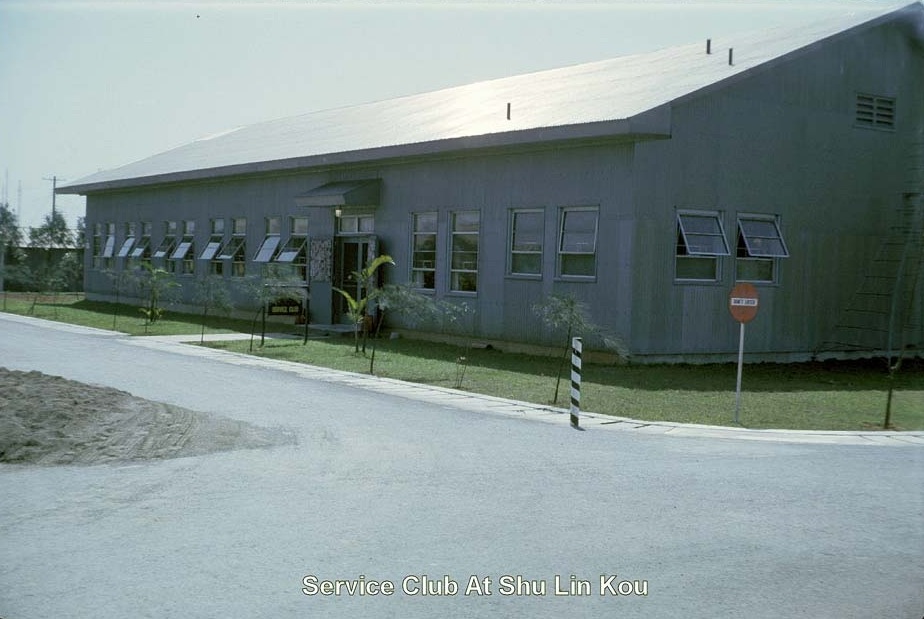
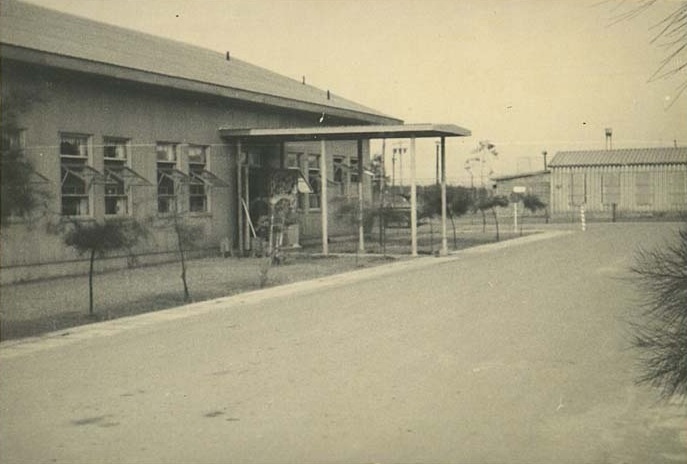
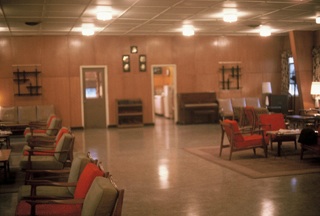
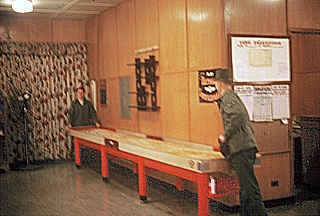
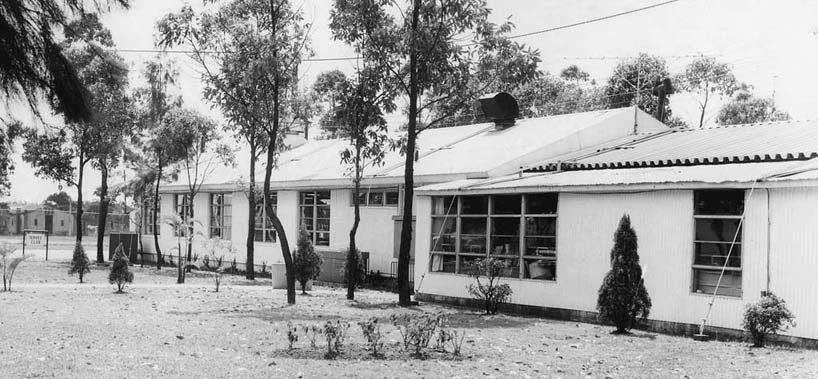
(5.) photo with permission and courtesy of the USAF ISR Agency History Office (below right) Shulinkou Air Station "Welcome Booklet" (1965) provided by S. Ellinger
(Click on Photos to Enlarge)
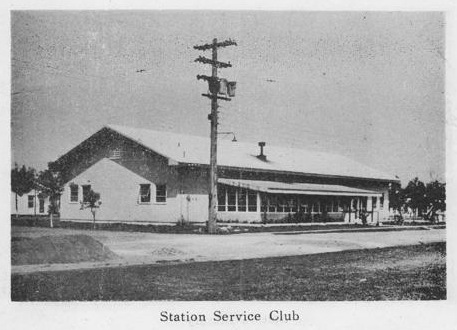 (1.) 1963 shot of the old Teapatch Service Club located right across the street from the old corrugated metal Operations Building, which is off to the right of the photo. In July 1965 the Service Club moved to building 132 to make way for the new permanent 210-man dormitories. (The Navy dormitory was built on the site of the old Teapatch Service Club.)
(2.) 1961 shot of the old Teapatch Service Club and the old metal Operations Building (far right).
(3. & 4.) 1963 interior shots of the old Teapatch Service Club, It was torn down in summer 1965 to make way for the new Navy (NSG) dormitory built on that site (reference the 1960 annotated aerial photo of base at top of page).
(5.) May 1969 shot of the new Teapatch II Service Club. The new Teapatch II Service Club opened at its new location in July 1965 on the site of the old Dispensary on the front corner of base adjacent to the base water tower (reference the 1974 base map at top of page, the Service Club is noted as number "20" - "Recreation Center" - Bldg. 250 on the map).
(1.) 1963 shot of the old Teapatch Service Club located right across the street from the old corrugated metal Operations Building, which is off to the right of the photo. In July 1965 the Service Club moved to building 132 to make way for the new permanent 210-man dormitories. (The Navy dormitory was built on the site of the old Teapatch Service Club.)
(2.) 1961 shot of the old Teapatch Service Club and the old metal Operations Building (far right).
(3. & 4.) 1963 interior shots of the old Teapatch Service Club, It was torn down in summer 1965 to make way for the new Navy (NSG) dormitory built on that site (reference the 1960 annotated aerial photo of base at top of page).
(5.) May 1969 shot of the new Teapatch II Service Club. The new Teapatch II Service Club opened at its new location in July 1965 on the site of the old Dispensary on the front corner of base adjacent to the base water tower (reference the 1974 base map at top of page, the Service Club is noted as number "20" - "Recreation Center" - Bldg. 250 on the map).
(Photo on Left-Click to Enlarge) 1965 shot of the back side of the old Teapatch Service Club. The old Operations Center is off to the far left of the photo.
Gary Knighton ('61-'63): On the right side of the Service Club there were four small private rooms, each with a window and door, where airmen could record messages to send home on the club's tape recorders. LP record albums could be checked out and played on the club's record players. TV wasn't available, but one night each week, Wednesday or Thursday, the Service Club would show different episodes of current TV shows on film including Johnny Yuma, starring Nick Adams. In addition, we enjoyed live performances by local Taiwanese men and women that ranged from traditional dancing to modern music.
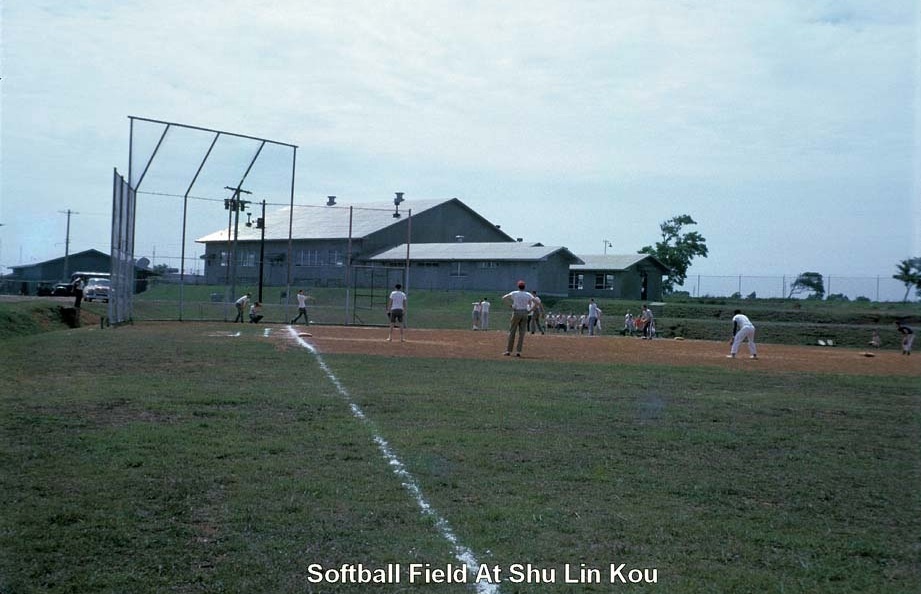
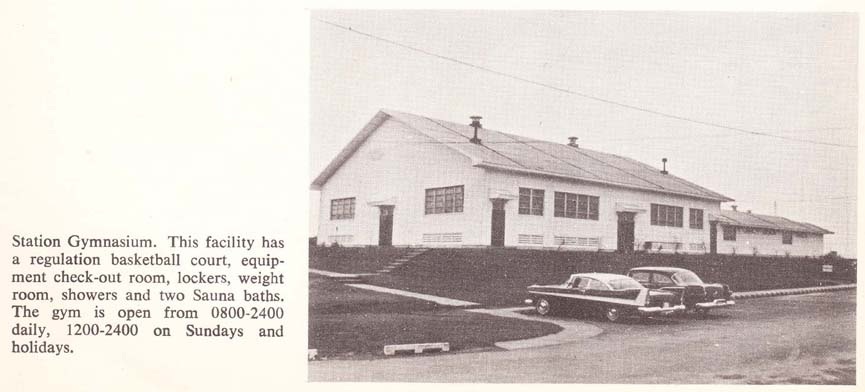
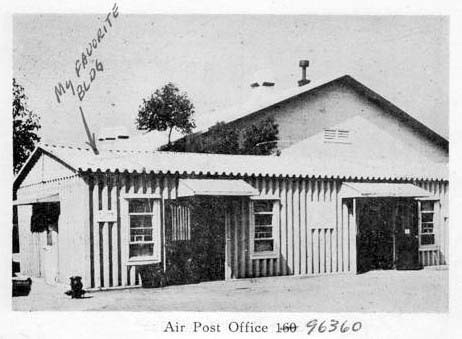
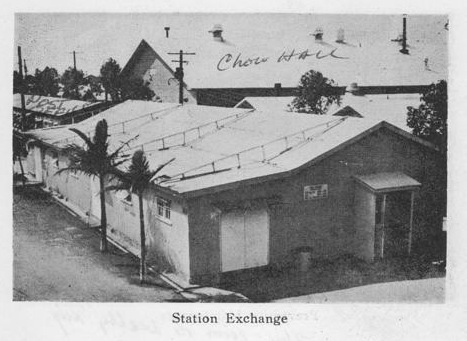
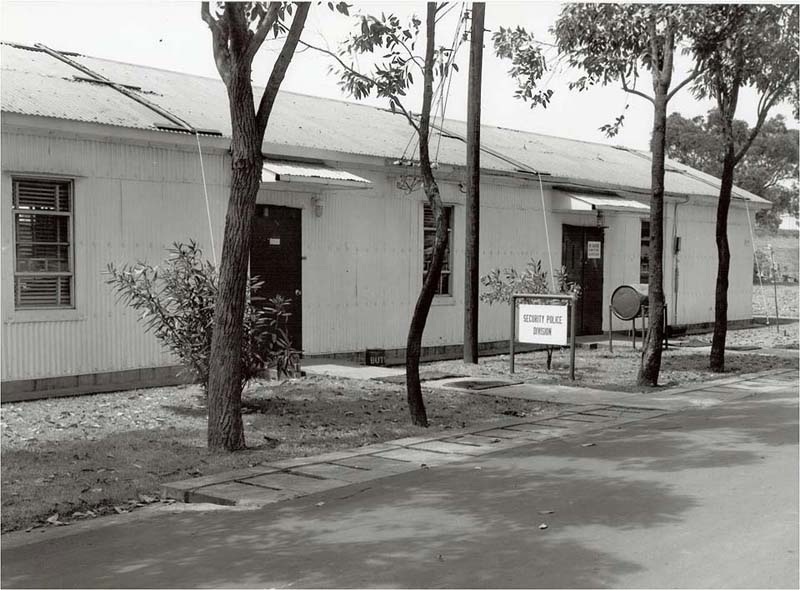
(5. & below right) photo with permission and courtesy of the USAF ISR Agency History Office (5.) Ben Hilmes ('62-'63)
(Click on Photos to Enlarge)
 (1.) Ball Field and Gymnasium 1962/63. Overhead lighting was added later.
(1.) Ball Field and Gymnasium 1962/63. Overhead lighting was added later.
(2.) Base Gymnasium 1965. The Ball Field is off to the right of the photo.
(3.) Mail Room (at "arrow"), Orderly Room (door on far right), and Dragon Inn Dining Hall (background) 1965. The Barber Shop was off to the right on the opposite end of the building. It was later relocated next to the BX behind the airmen's dormitories.
(4.) Old Base Exchange 1965 ("PX" on map top of page) that was later relocated behind the new dormitories. Dragon Inn Dining Hall is in background.
(5.) Linkou Security Police Headquarters May 1969 next to the Navy dormitory (off to right).
(Right Photo) May 1969 shot of the Navy dormitory.
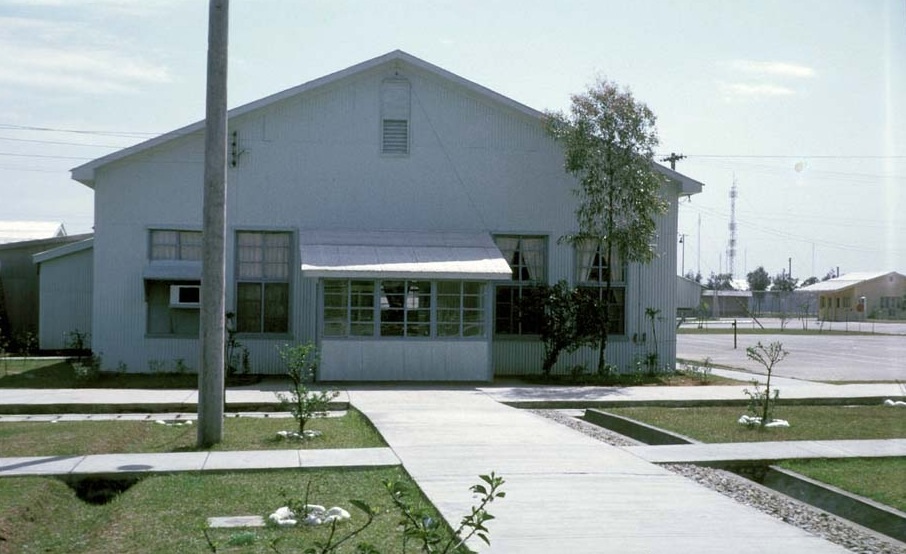
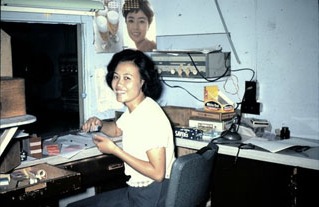
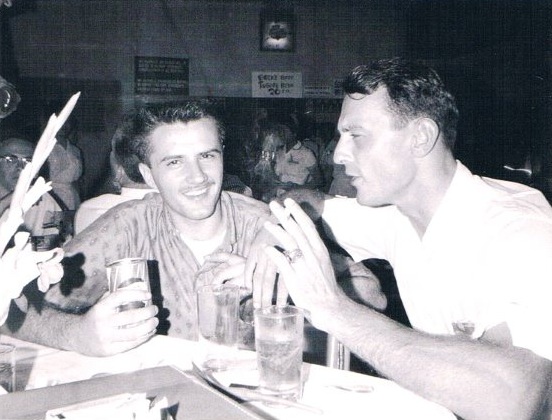
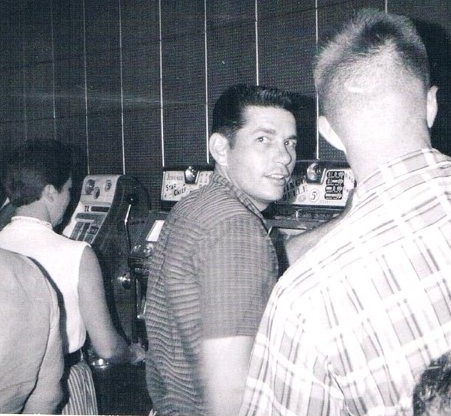
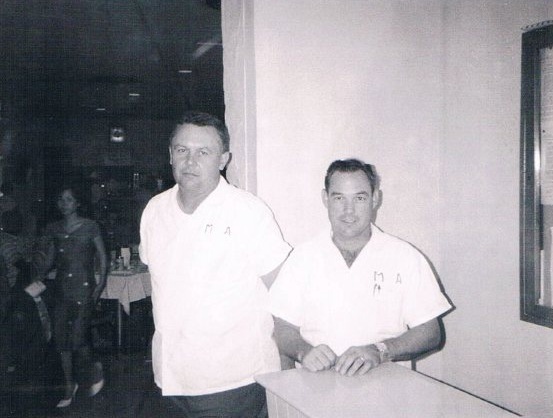
(Click on Photos to Enlarge)
(1.) 1962/63 shot of the rear of the Linkou Club, Tennis/Basketball Court (right), and original Main Gate (far right). The new Dispensary (photos above) was later built on the site of the Tennis Court. (2.) Cashier Liu in the Linkou Club's Cashier's Office on the Hill 1962. (3.) Jim Long (left) and Tom Smith in the main Linkou Club on the Hill 1962. The sign on the wall in the background reads "Beck's Beer, Tuborg Beer, $.20 each" (...Tuborg is a Danish beer.). (4.) Buddy (facing camera) at the Linkou Club's slots on the Hill 1962. (5.) Unidentified MA's at the entrance to the Linkou Club Annex in Taipei 1962. The club's main dining room is visible in the background.

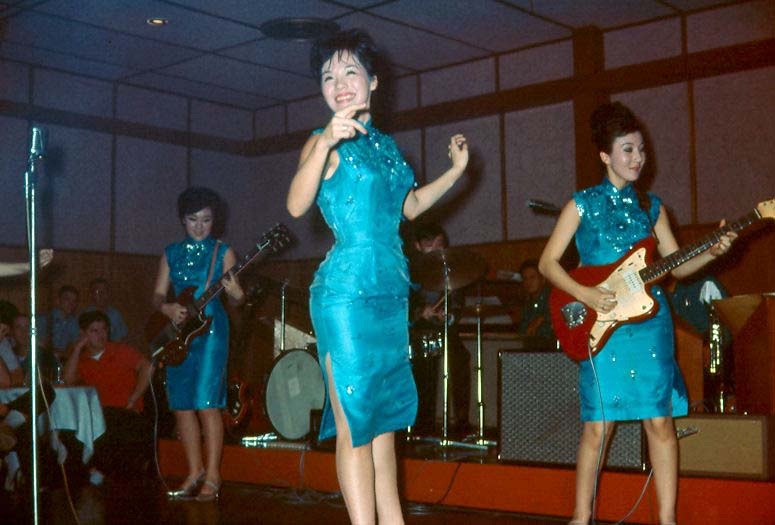
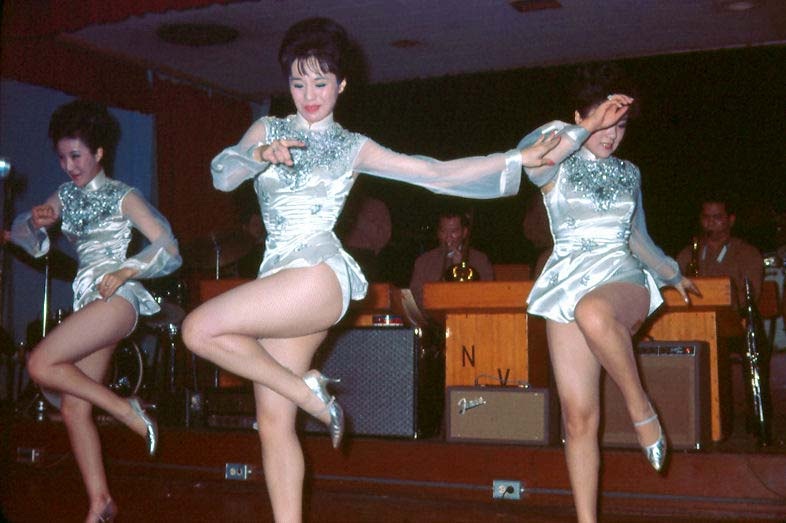
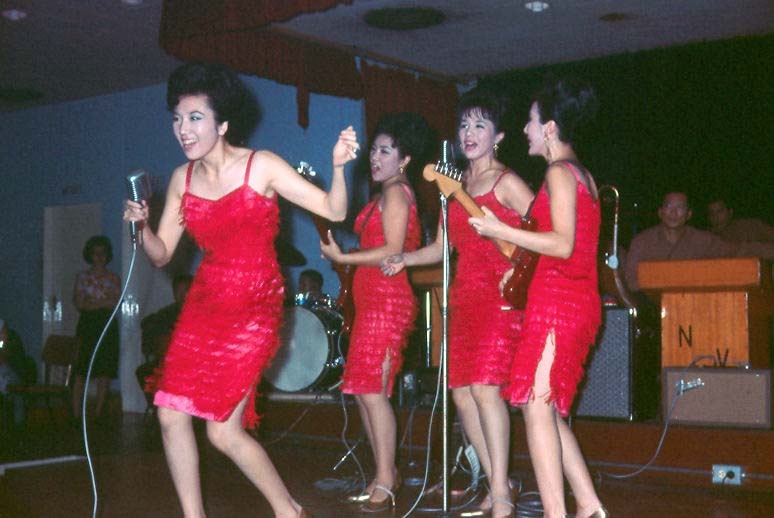
Les Duffin (1962-1966): "This was a group (photos above) named Sing Lee Sing, a San Francisco Chinese family with four daughters and a young son who put on a show in 1962 at the main Linkou Club on the Hill (photos 1. & 2.) and the Linkou Club Annex in Taipei (photos 3. & 4.). They were singers, musicians, dancers, and acrobats all rolled into one. You’ll note Nick and the band backing them up." [23 March 2010] NOTE: Scheduled USO performances in Taipei included both Linkou clubs.
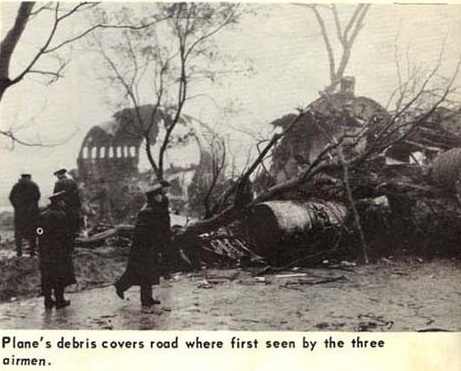
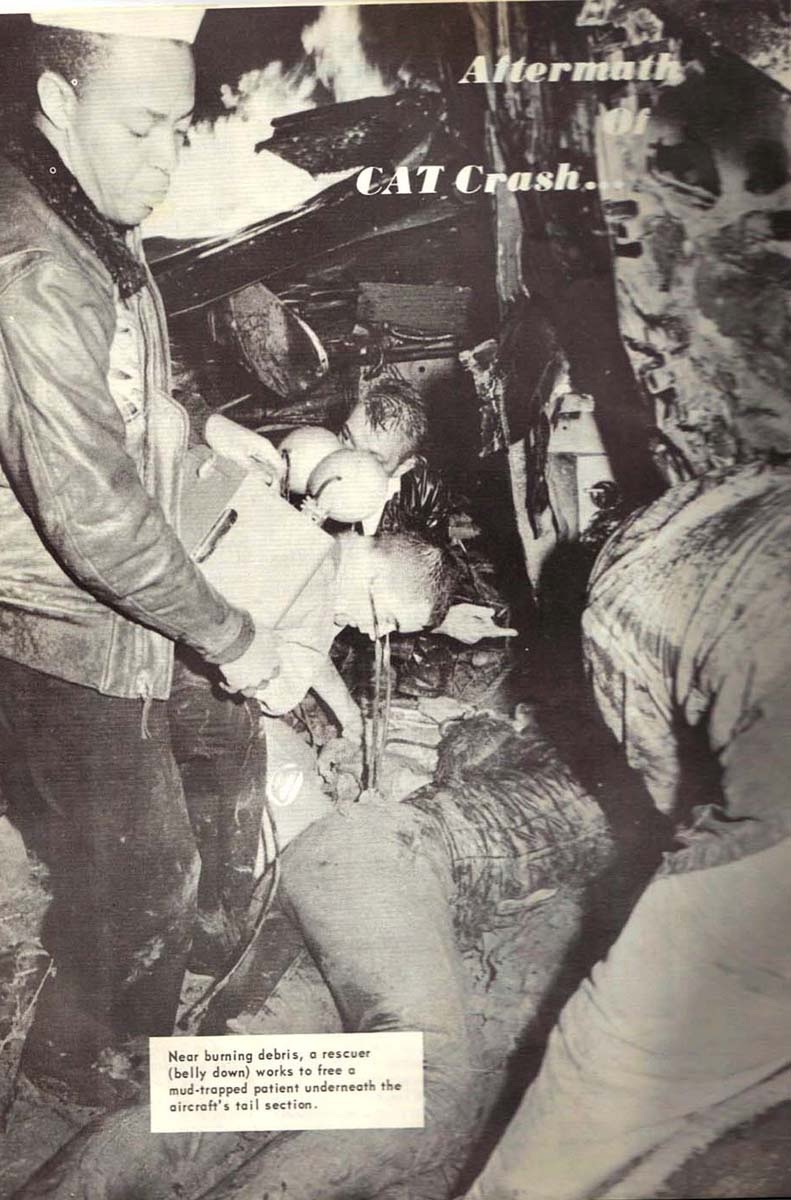
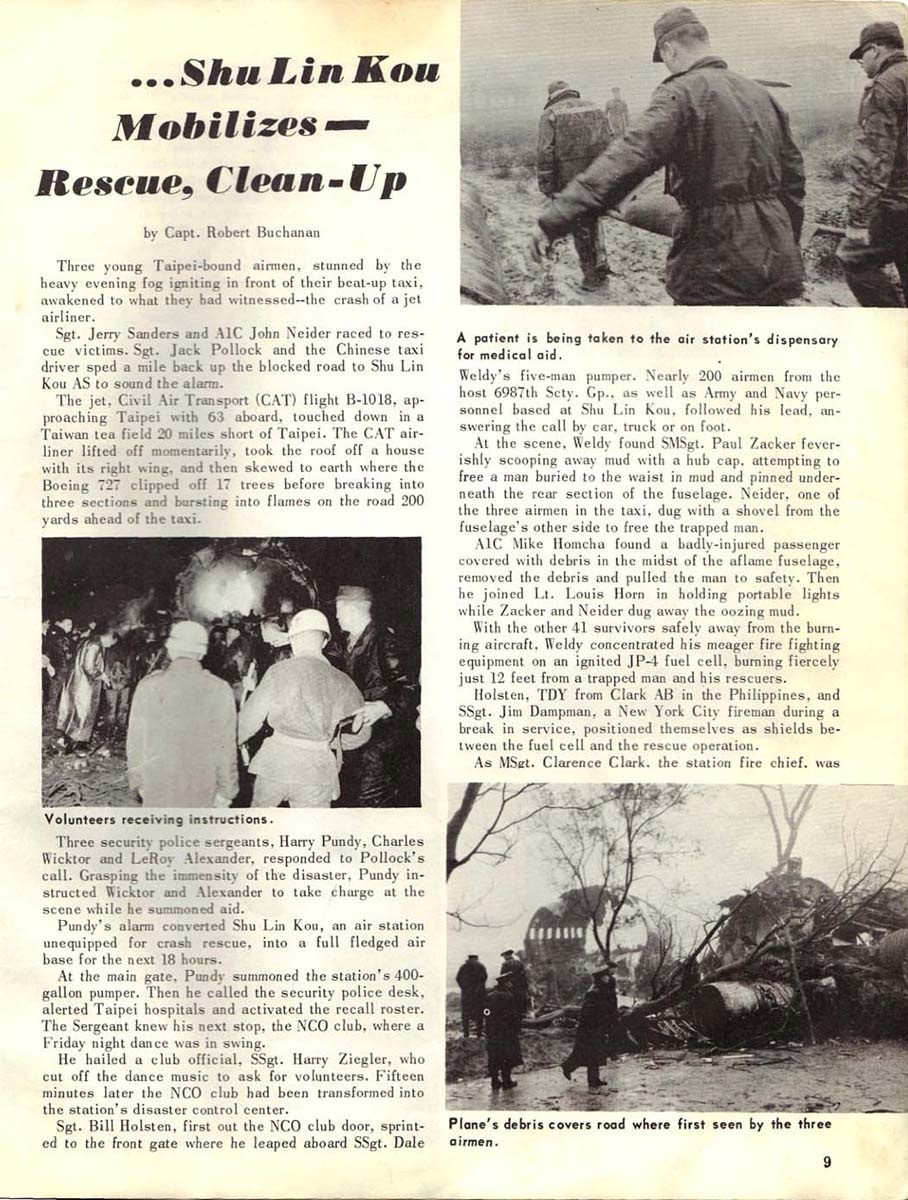
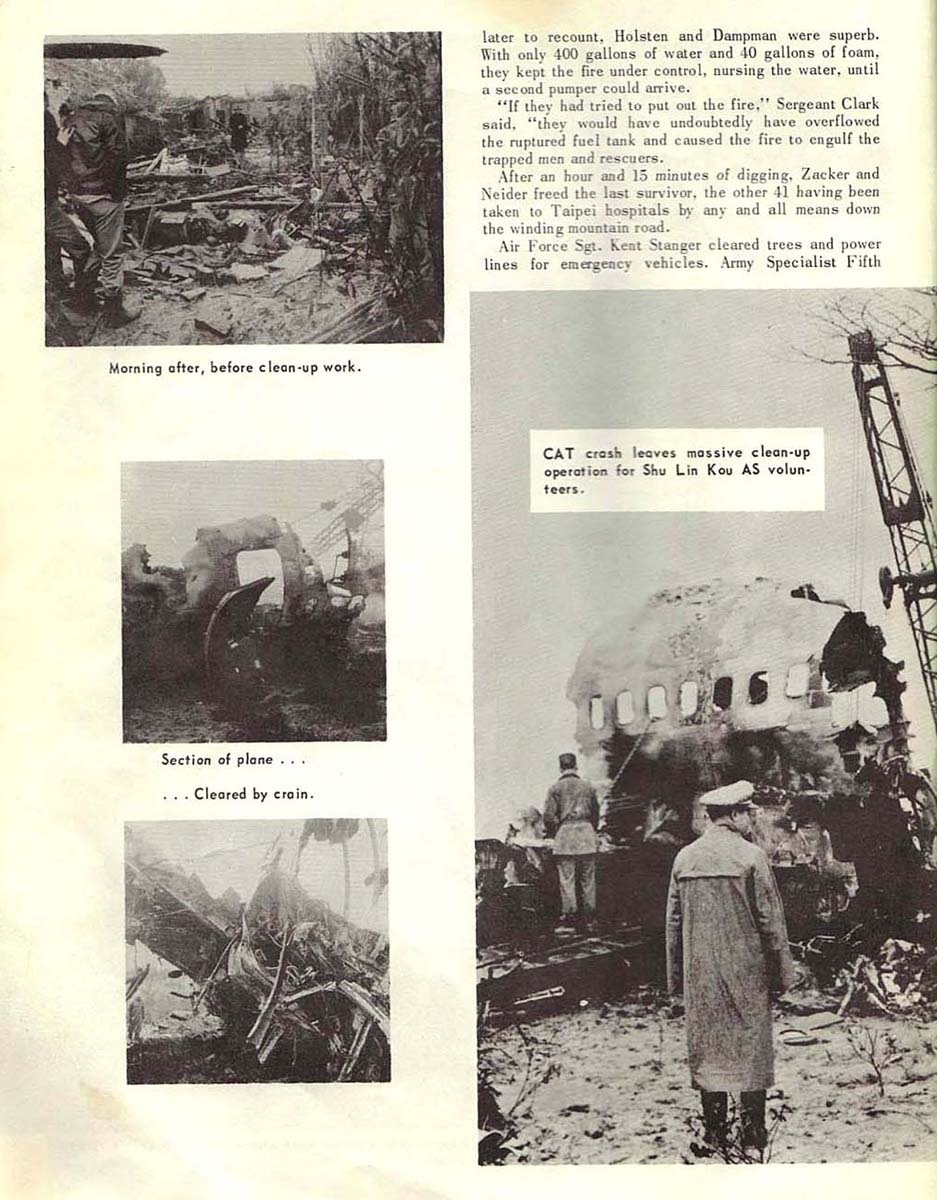
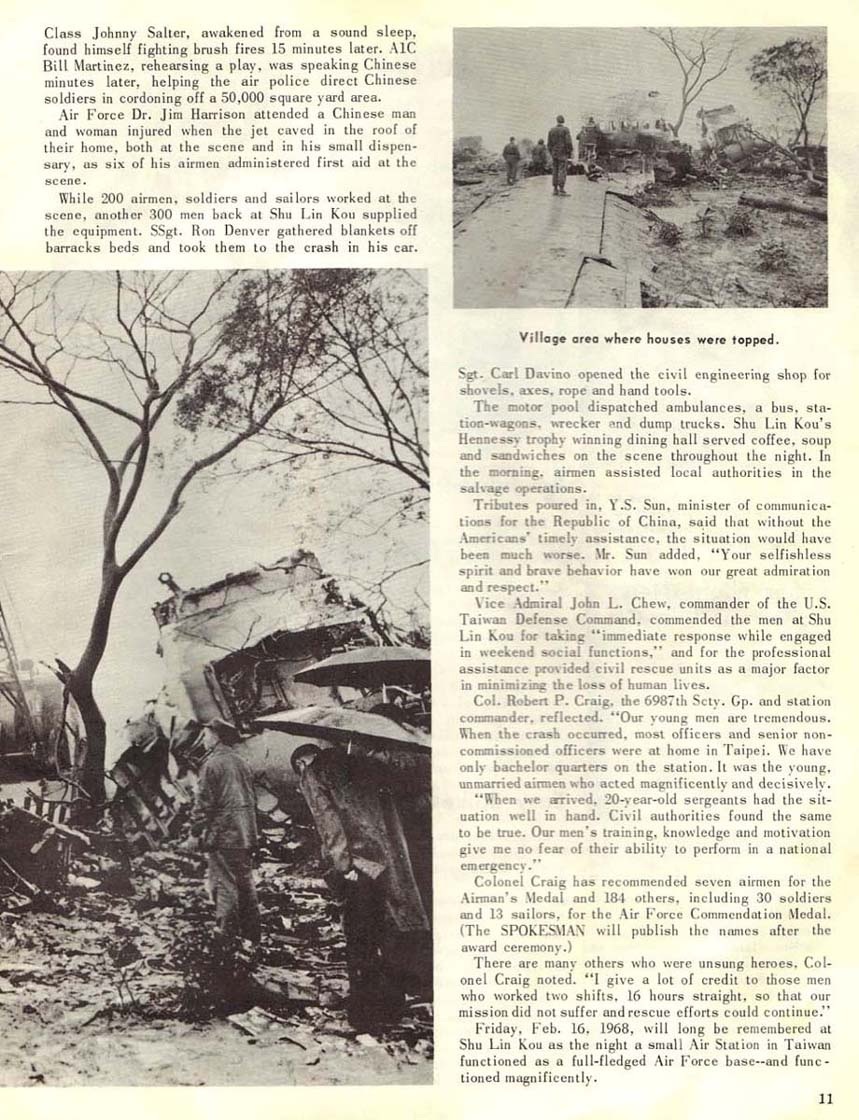
(Click on Images to Enlarge - To Zoom In click again after opening)
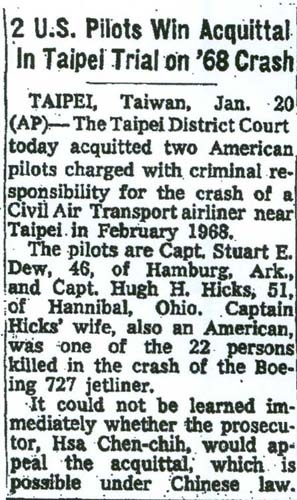 1968 article from "The Spokesman", a USAFSS magazine, about the CAT Boeing 727 jetliner crash in the tea fields surrounding the village of Linkou. On the rainy and foggy night of Friday, February 16, 1968, CAT flight B-1018, nosed into a tea plantation one mile from Shulinkou Air Station while on approach to the Taipei International Airport killing 22 of the 63 persons aboard. Shulinkou firemen and base personnel greatly aided in the rescue of the survivors. First on the scene, as referenced in the article above, were Dawgs Flight's Jerry Sanders, John Neider, and John Pollock (click for photos), who were in a taxi heading to Taipei when the plane went down near their cab. John Neider ('67-'68): "... a few Flights from base were involved, but the most of the names in the article (above) were from Dawg Flight." Neider, Pollock, and Sanders were awarded the Airman's Medal (click for website) in October 1968 by Col Robert P. Craig, Linkou Base Commander, for their heroic actions that night.
1968 article from "The Spokesman", a USAFSS magazine, about the CAT Boeing 727 jetliner crash in the tea fields surrounding the village of Linkou. On the rainy and foggy night of Friday, February 16, 1968, CAT flight B-1018, nosed into a tea plantation one mile from Shulinkou Air Station while on approach to the Taipei International Airport killing 22 of the 63 persons aboard. Shulinkou firemen and base personnel greatly aided in the rescue of the survivors. First on the scene, as referenced in the article above, were Dawgs Flight's Jerry Sanders, John Neider, and John Pollock (click for photos), who were in a taxi heading to Taipei when the plane went down near their cab. John Neider ('67-'68): "... a few Flights from base were involved, but the most of the names in the article (above) were from Dawg Flight." Neider, Pollock, and Sanders were awarded the Airman's Medal (click for website) in October 1968 by Col Robert P. Craig, Linkou Base Commander, for their heroic actions that night.
In October 1968, a total of seven personnel were awarded the Airman's Medal for heroism involving voluntary risk of life while helping survivors of the CAT crash on February 16. Three others involved received Air Force Commendation Medals.
NOTE: The CAT Boeing 727 jetliner was flown by two American pilots who survived the crash. The wife of one of the pilots perished. Both pilots were tried and acquitted in a Taipei court. (Article on Right-Click to Enlarge) New York Times, Jan. 21, 1969
Les Duffin (1962-66): "There was an official pre-planned evacuation route from SLK in case the commies ever invaded the island. It ended up somewhere along the east coast where the evacuees were supposed to be picked up (maybe by the Navy). The theory was that if the invasion ever came, we were all supposed to high-tail it out the gate and walk the route to the pickup point (...taking 3 to 5 days). There was a requirement for someone to actually test the route by walking it once a year or so by volunteers. I remember friends of mine making the trip and returning with the opinion that it was totally impractical: it would have taken longer than planned, and by the time we could have reached the coast it would probably have been too late anyway." [14 June 2009]
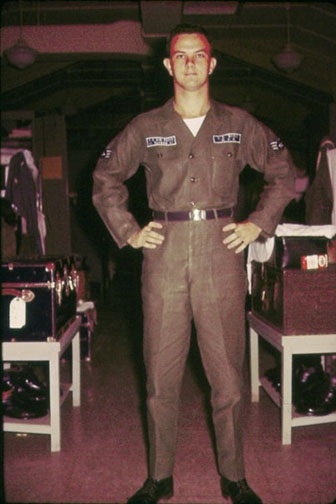
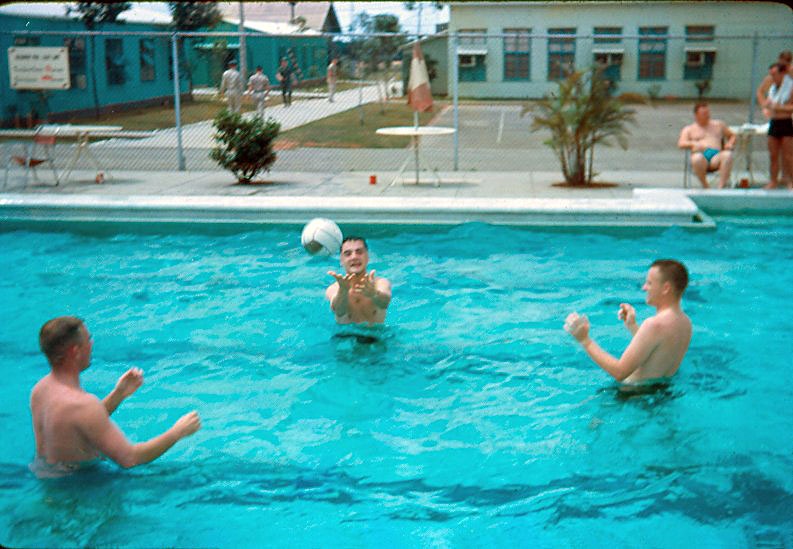
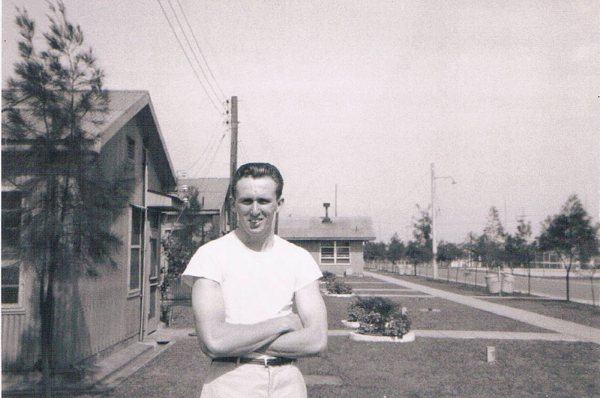
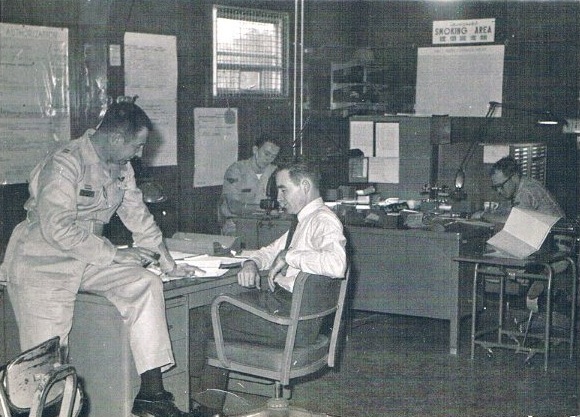
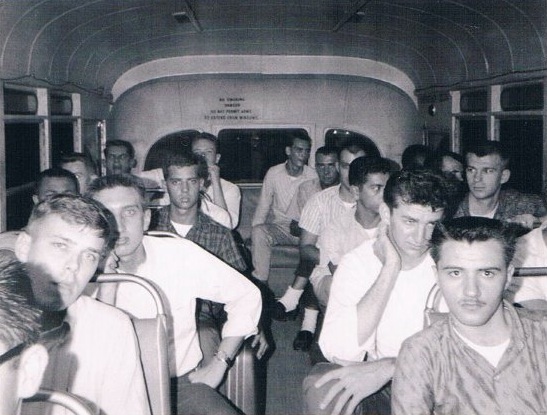
(1.) 1963 shot of A1C Les Duffin (203: '62-'63, '64-'66) in his open-bay barracks. Note the footlockers in the background. (2.) (From left): Larry Plunkett, Emerson O'Melia, and Gerry Walsdschmidt (1963 photo)...all were Les Duffin's classmates in basic Chinese. Blue corrugated-metal barracks (left), Tennis/Basketball Court (right) and Linkou Club (right background). (3.) Arthur "Chuck" Mulligan ('61-'62) in front of his barracks. The Teapatch Service Club is off to the right across the street. (4.) 1961 shot inside the Unit Supply Office. (From left) Capt. Trahan on desk, A2C Arthur Mulligan (background), TSgt. Arsenalt and Bill Taylor (far right). (5.) 1961/62 shot of "Chuck" Mulligan's buddies returning to Linkou from Taipei on the last bus up the Hill after midnight. Jim Long (foreground-far right), Tom Smith (hand on face-left rear), Paul Bender (center-rear seat), Cook (203) on left. All others unidentified.
Arthur "Chuck" Mulligan, 1961-62 (photos above): "I was stationed at Shulinkou from May 1961 to Aug 1962 in the Unit Supply Section responsible for maintaining the UAL listing of all the Radio Equipment used on the site. All the airmen in my barracks worked inside the compound (291s, 292s, and 203s), but I have no idea what they did because they never talked about it. It was a great experience...something I will never forget." [21 Dec 2010]
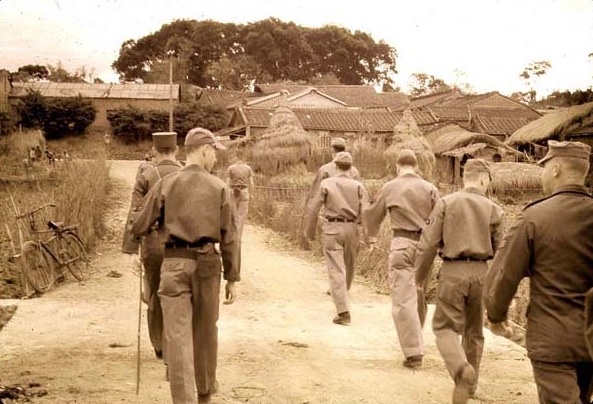

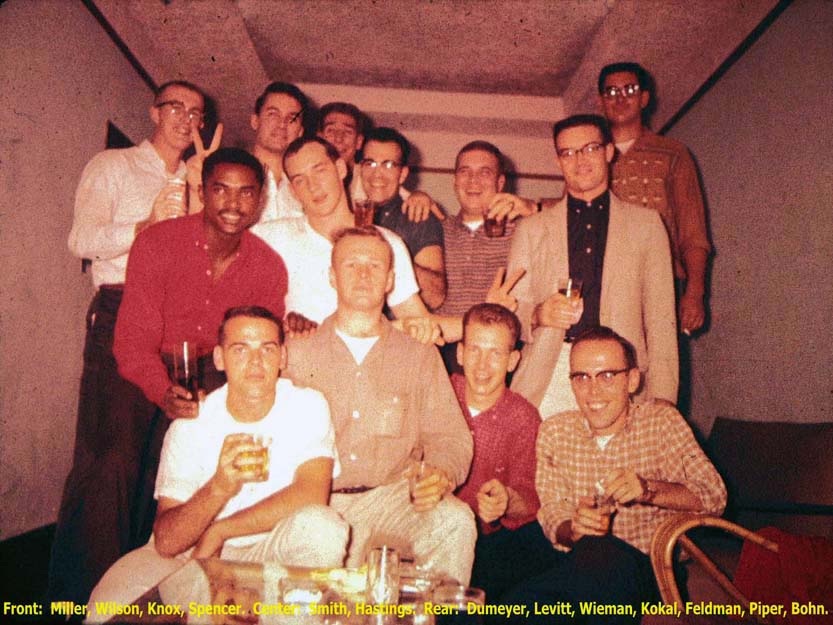
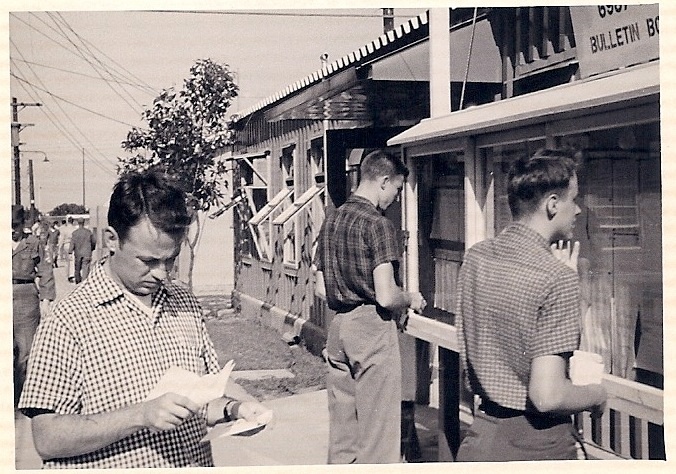
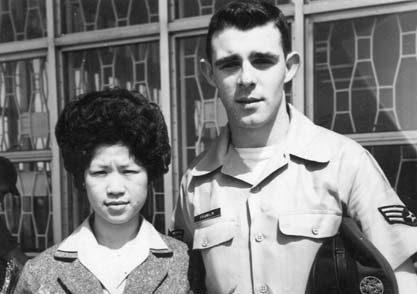
(1.) 1962 shot of Gary "Yogi" Knighton (1961-63, far right corner) and Charlie Flight on a "physical fitness hike" inspired by then president John F. Kennedy and the base commander.
(2.) Photo of the Spring 1962 NCSA Karate Black Belt class (names in photo caption) at the Linkou Gymnasium provided by Michael Miller (203: '61-'62), seated on right. The sign on the upper right reads: Put Weights Back When Done Or Forfeit Right To Use Them. A.I.C. of GYM (Airman in Charge).
(FRONT ROW) L-R: Bob Cruz, Ch'en Mei Shou (Instructor) Karate Master 5th Degree, Mike Miller. (BACK ROW) L-R: Jim Bohn, Earl Wieman, Jack Levitt, Chris Smith.
(3.) Michael Miller ('61-'63): "Photo of members of the April 1960 Basic Chinese class at IFEL who served at Shulinkou in 1961-62. This photo was taken around November 1962 when the group was about to return to the US mainland." They are as follows (including home states): (FRONT-from left): Michael Miller (CA), Robert Wilson (OR), John Knox (TX), Rolland Spencer (MI)
(CENTER): Wilbur "Chris" Smith (NY), Frank Hasting (MD)
(REAR): John Dumeyer, Jack Levitt (TX), Earl Wieman (KY), Richard Kokal (MN), Gilbert Feldman (MD), David Piper (MA), James Bohn (PA)
(4.) 1961/62 shot of Earl Wieman (right) and an "unidentified" airman at the "6987th Bulletin Board" located across the sidewalk from the Dining Hall, which is off to the left of the photo. Charlie Biggs, is reading a letter from the Mail Room, which is to the right of the bulletin board.
(5.) March 1962 shot of A1C William Franklin and his wife in Taipei shortly before departing Taiwan that month.
William Franklin. 1959-62 (MSgt. USAF Retired): "I was there from March 1959 to March 1962, radio maintenance, and worked with the installation team from Japan installing equipment in the new ops wing (prior to completion of the new concrete operations building in 1963/64) so the trailers could be removed. I also worked briefly in the separate Army ASA compound before it closed down when they moved into the new ops building with the Air Force. ...My wife's father and a Mr. Chen ran the "Soon-Send Employment Agency" in Taipei where many of the accompanied GIs would go to hire a maid." [10 Sep 2010]
Sam Buemi (Dawg Flight 1963-65): "I remember hearing about a movie crew checking out shooting locations for "The Sand Pebbles" around Taipei in 1964. My uncle Pete Belsito, was in the 15th Infantry Regiment ("Can-Do" outfit) stationed in China from 1912 to 1938 and was there in the 1920's [the book/movie is set in China 1926], he also served in the Philippines. He ran away from home because he didn't want to work the coal mines in Latrobe, Pa. and was probably a volunteer for China, like most of the unit." [19 June 08]
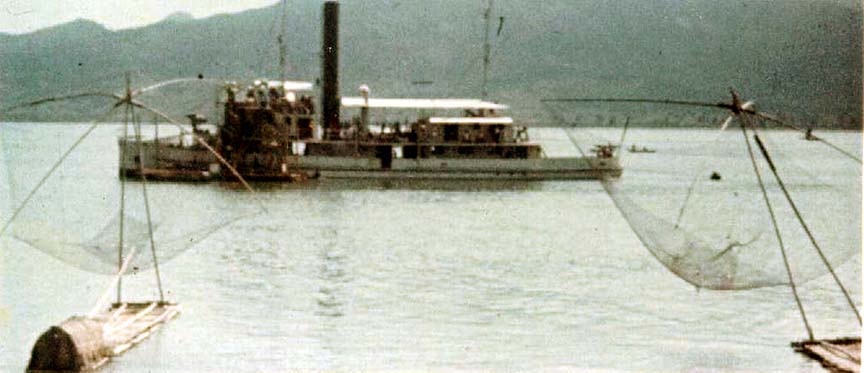
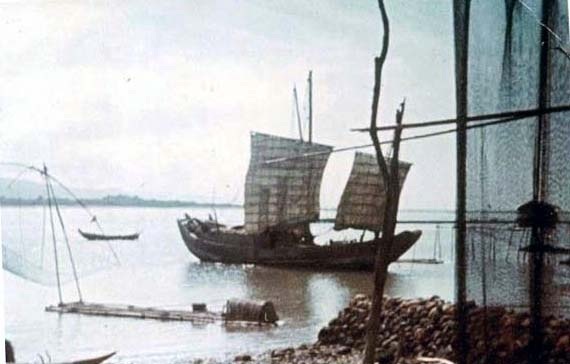
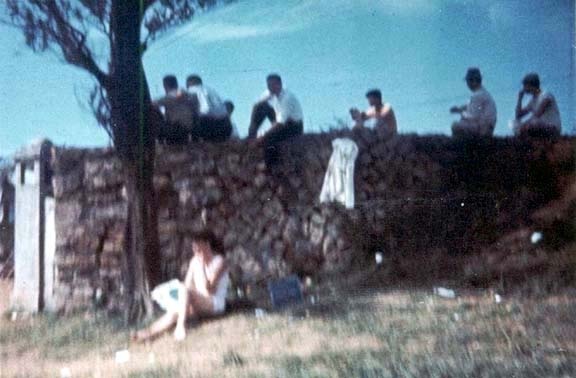
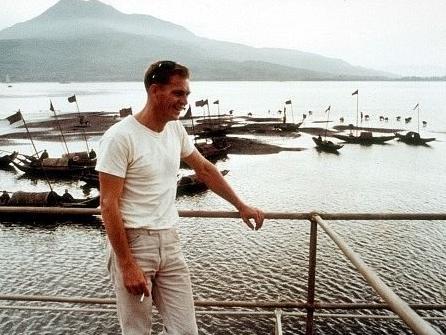
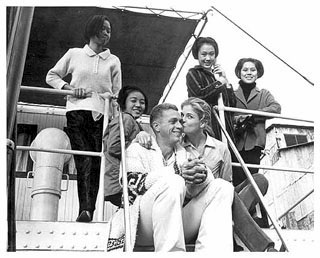
(Click on Photos to Enlarge)
(1.) 1965/66 shot of the gunboat USS Panay on the Keelung River during the 1965-66 filming of the 1966 hit movie, "The Sand Pebbles" (Click Here) starring Steve McQueen, Candice Bergen, Richard Crenna, and Richard Attenborough. "...Filming began November 22, 1965 at Keelung, Taiwan. (Portions of the movie were filmed in Taiwan and Hong Kong.) It was scheduled to take nine weeks but ended up taking seven months. The cast and crew took a break for the Christmas holiday at Tamsui, Taipei (not far from Linkou)..." [Wikipedia] (Photo by Gary Frederick, Charlie Flight 1965-66.)
(2.) 1965/66 shot of Chinese junk on the Keelung River used in the production of "The Sand Pebbles". (Photo by Gary Frederick, Charlie Flight 1965-66.)
(3.) 1965/66 shot of members of Charlie Flight on the banks of the Keelung River watching the filming on "The Sand Pebbles". (Photo by Gary Frederick, Charlie Flight 1965-66.)
(4.) 1966 shot of Steve McQueen in Tamsui, Taiwan during the filming of "The Sand Pebbles". Mount Guanyin ("Linkou Mountain") is in the background.
(5.) Steve McQueen and Candice Bergen on location during the 1965-66 filming of the 1966 movie, "The Sand Pebbles".
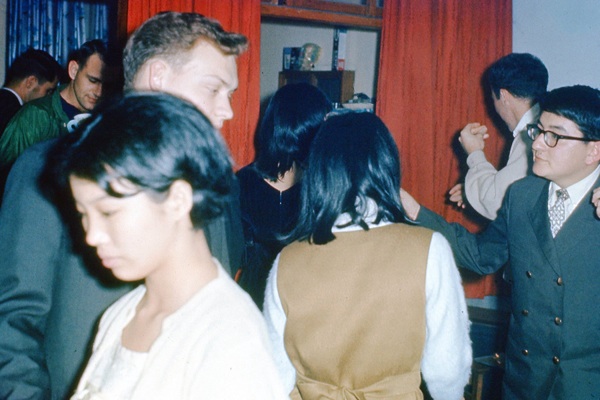
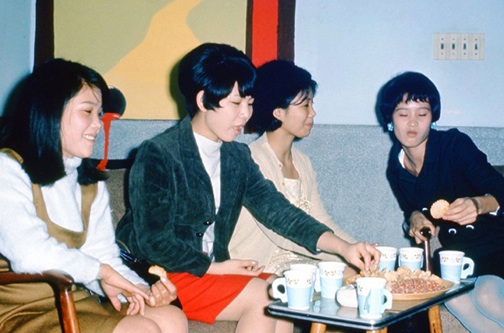
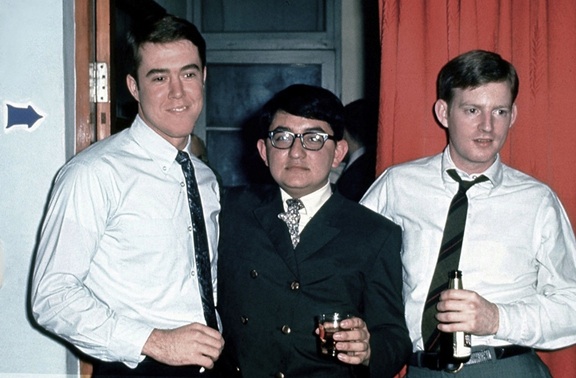
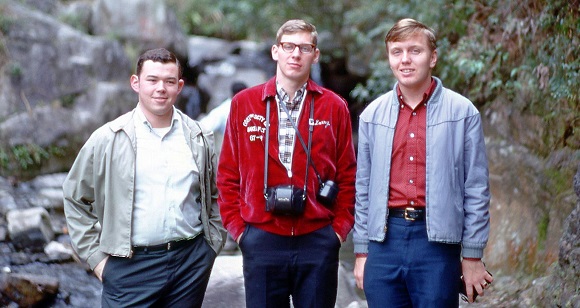
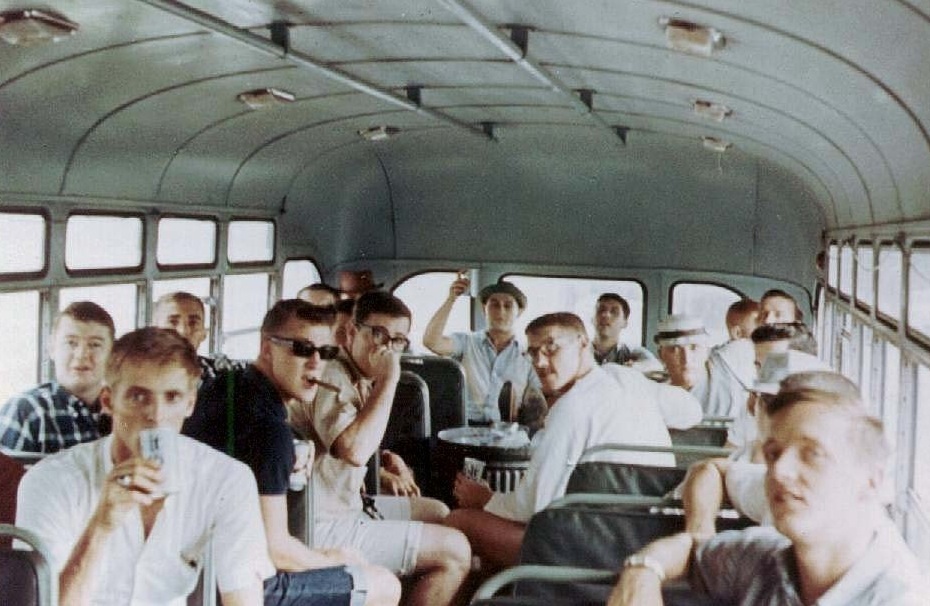

(Bottom Row) (1. & 2.) Gary Frederic (Charlie Flight: Aug 1965 to Nov 1966)
(Click on Photos to Enlarge)
(Top Row) (1.) Ron Orr, Rick Sosapavon, Ron Colvin - Baker Flight apartment party, Taipei 1967.
(2.) Baker Flight apartment party guests, Taipei 1967.
(3.) (L-R) John Quinlan, Rick Sosapavon, Mike O'Donnell - Baker Flight apartment Party, Taipei 1967.
(4.) 1967/68 shot of Tom Yearnshaw (left - Baker Flight 202, 1967-68) with unidentified Baker Flight 202s.
(Bottom Row) (1.) 1966 shot of Charlie Flight on the Navy bus from Shulinkou heading to a McCauley Beach party. (front to rear): Cornette, Charles "Fred" Cox, Ross Richards, Jib, Moose (Nunn), Clark, Fitzgerald, Clinton, Piper, Eagleson, Mariatis, Red Elliott.
(2.) Charlie Flight returning to base from the beach party (1966). (L-R) Krider, White (black trunks), Gary Frederic (doorway), Cornette (striped shirt), Charles "Fred" Cox (glasses), and driver.
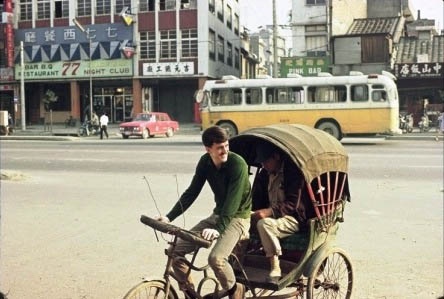
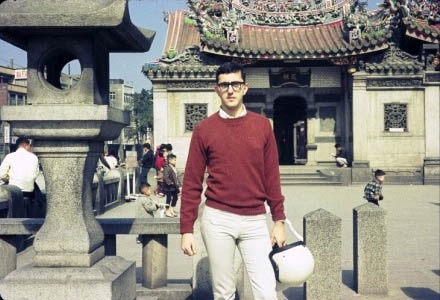
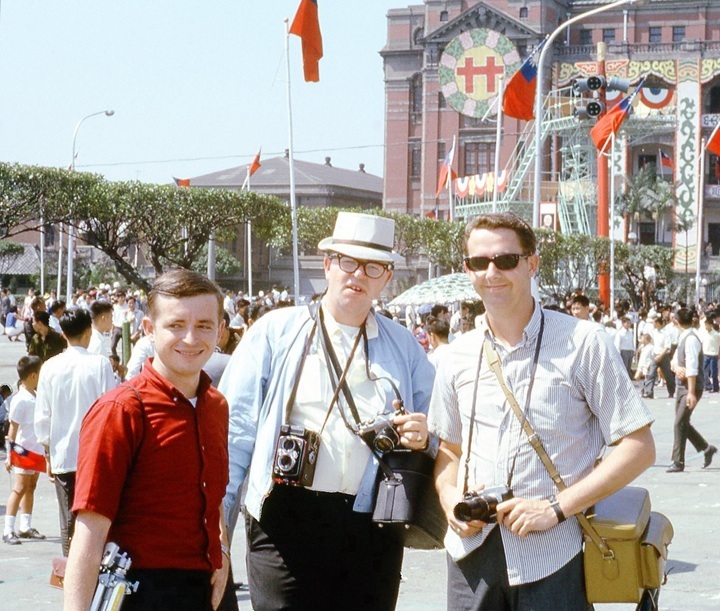
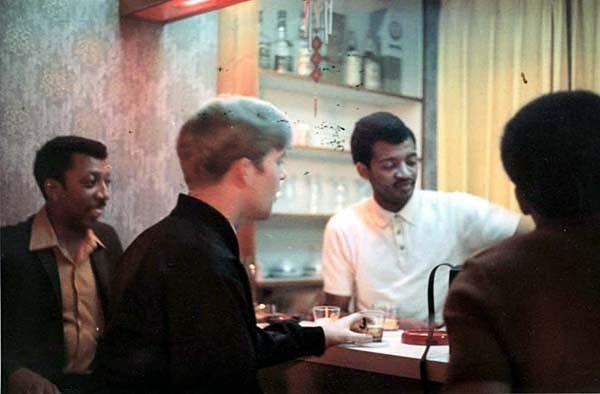
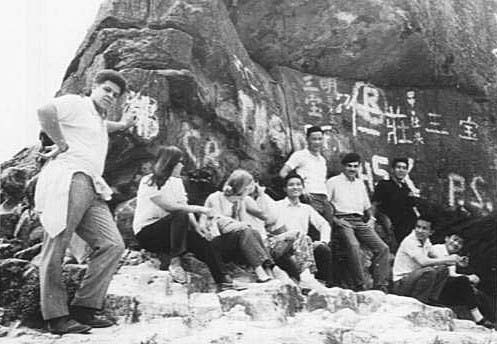
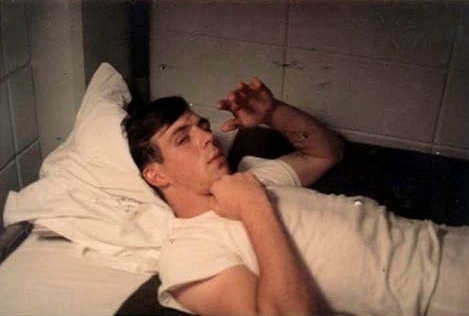
(Bottom Row) (1., 2., & 3.) Paul Birden (Charlie Flight 1969-70).
(Top Row) (1.) 1967/68 shot of Dave "Hippy" Holt (Able Flight) going on a joyride on a pedicab near the Pillbox in Taipei. (2.) 1968 shot of Mike "Skeeter" Homcha (Able Flight '67-'68) in Taipei. (3.) Double Ten Day, October 10, 1967. Able Flight members: Unidentified (left), James Coronet (middle), and Vern Layton (right) at the Presidential Office Building (background) in downtown Taipei.
(Bottom Row) (1.) Charlie Flight party 1969/70. Lou (last name unknown-Charlie Flight 202: '69-'70) behind the bar in his Taipei apartment. Paul Birden (far right-Charlie Flight 203: '69-'70) and two other unidentified Charlie Flight guests. (2.) Charlie Flight 203s ('69-'70) Paul Birden (far left) and Gene Mucciolo (center-beret) on a hike in the Taipei area (1969/70 photo).
(3.) 1969/70 shot of James "Jim" Wade, Paul Birden's roommate, in the Charlie Flight barracks.
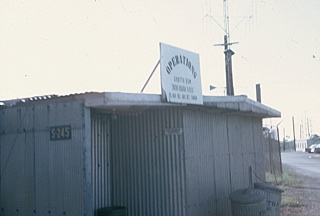
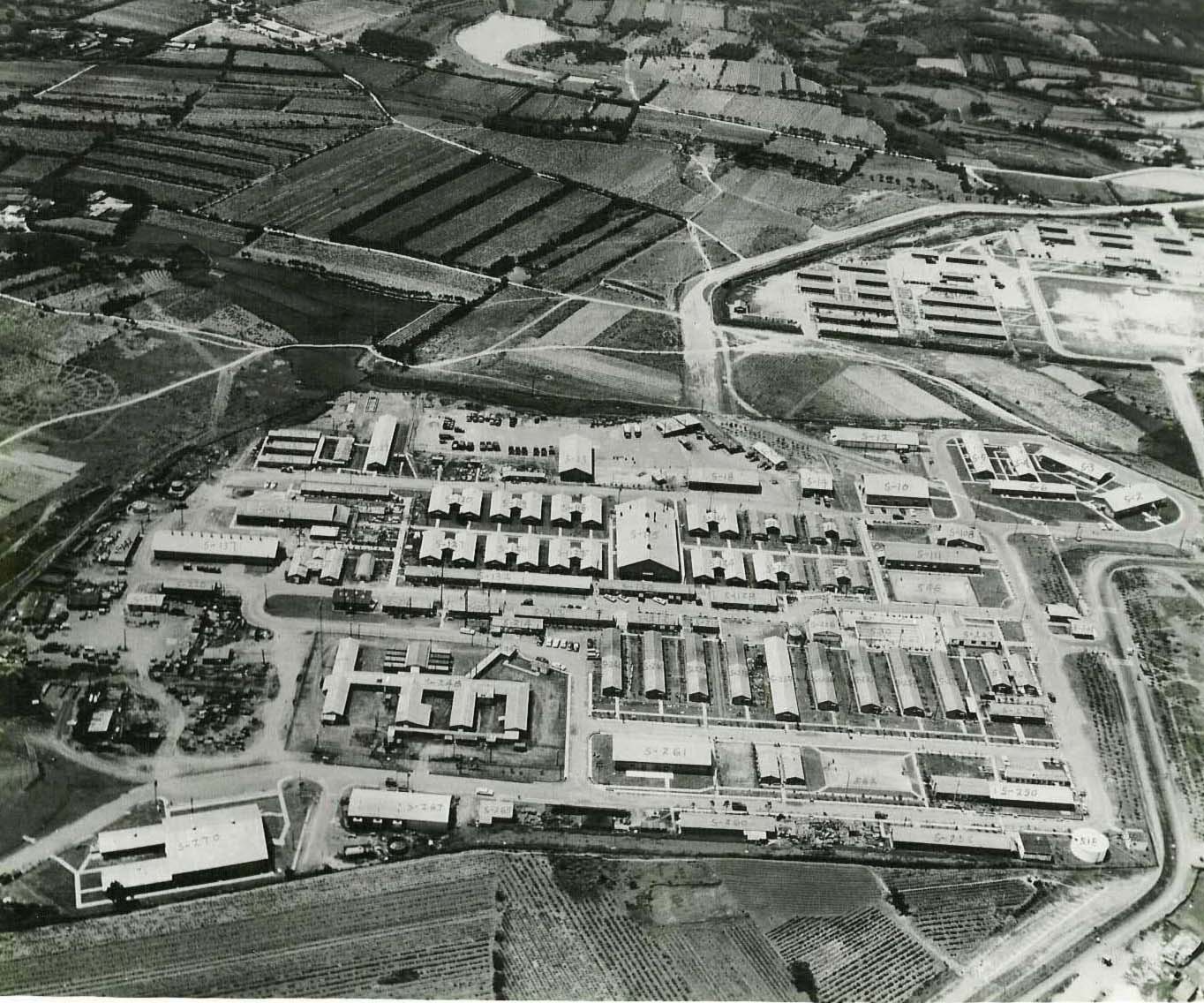
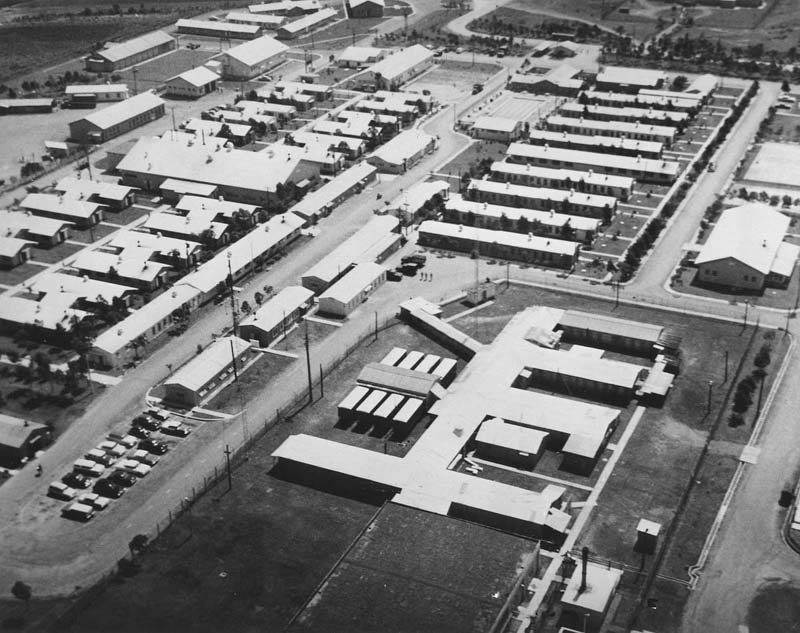
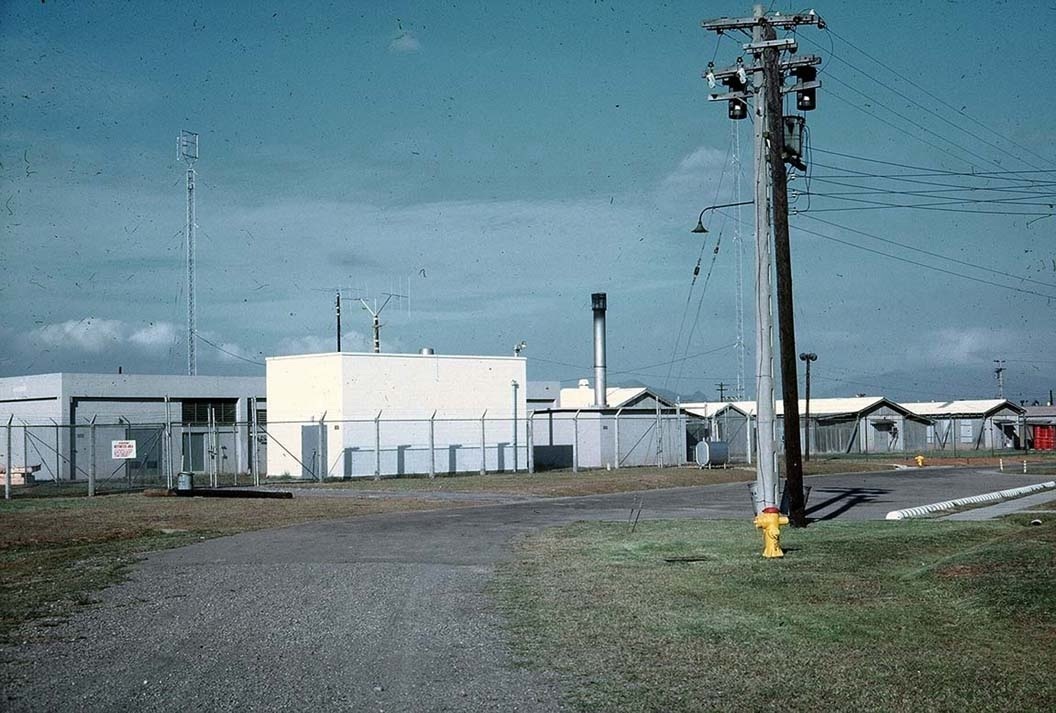
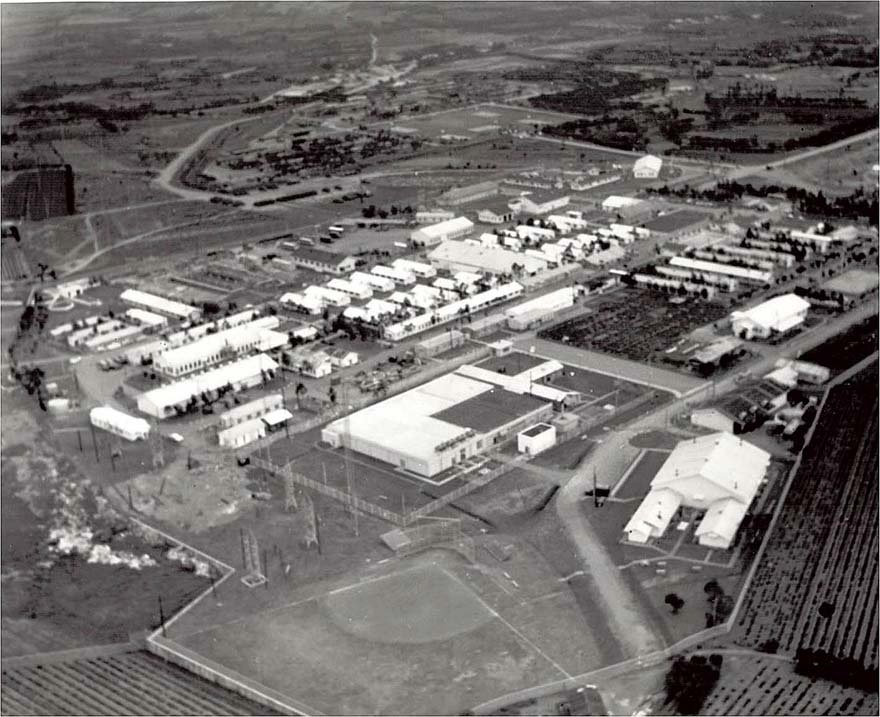
(Click on Photos to Enlarge)
(Top Row Above) (1.) 1962/63 shot of the entrance to the old corrugated metal 6987th RSM Operations Center (no. S-245).
(2.) 1960 aerial photo of showing the old Ops Building (large long bldg-lower left). The open area to its left (lower far left of photo) was the site of the new concrete Ops Center. Construction commenced late 1961 or early 1962 and completed late 1963 or early 1964. The base Gymnasium is the large building in the lower left corner of the photo.
(3.) 1963 aerial photo of the completed first phase of the new Ops Center building (foreground) with the old building attached and still intact. The left side and rear of the new Ops Center were expanded during the second phase of construction as shown as the white area of the completed building's roof in photo no. 5 above. Note the ASA vans that are attached to the old Ops Center building.
(4.) March 1963 shot of the right side of the new concrete Ops Center and Compound.
The new burn-bag incinerator and metal chimney (center of photo) are visible in the Operations Compound. The base Gymnasium is just off to the right of the photo. The old gray metal Ops Center (right -pitched roofs) was still operational when this shot was taken.
(5.) 1965 aerial photo showing the completed new Operations Center and Compound. The old Ops Center was torn down and construction is starting on the three new Air Force dormitories on that site (photos below). A new street was added between the new Ops Center and site of the new barracks dormitories. In July 1965 the old Teapatch Service Club (white bldg on far right) was moved to building 132 to make way for the new dormitories. (The Navy dorm was built on the former site of the Teapatch Service Club.)
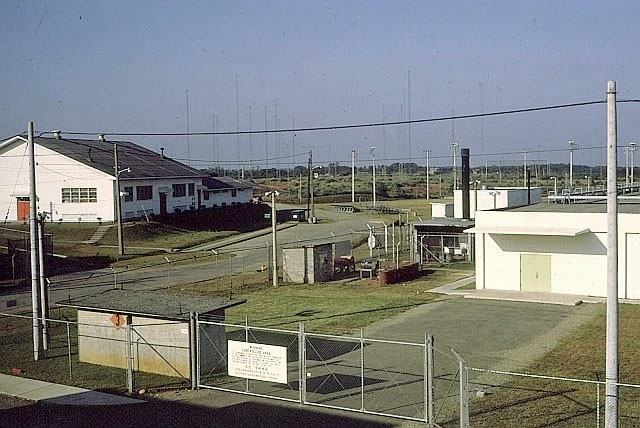


(Click on Photos to Enlarge)
(2.) 1966 shot of the Operations Compound, new Operations Building, and Guard Shack taken from the stairwell landing outside the Dawg Flight barracks in the new dormitories.
(3.) 1969 photo of the Guard Shack (far left), Operations Building and Compound, and the Ops Center's antenna field (background). Accounting & Finance is just off to the left.
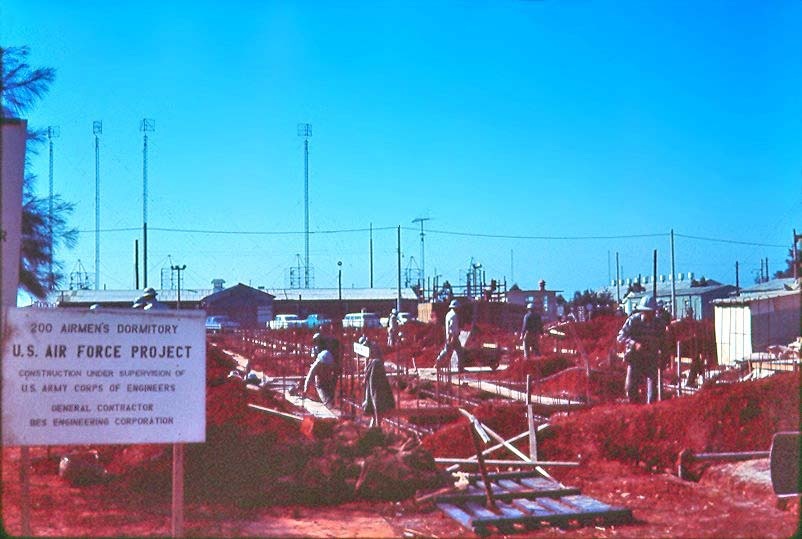
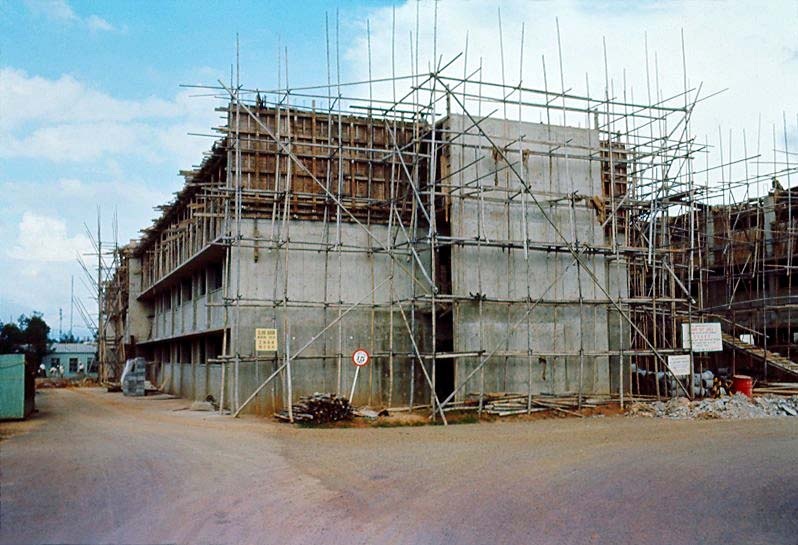
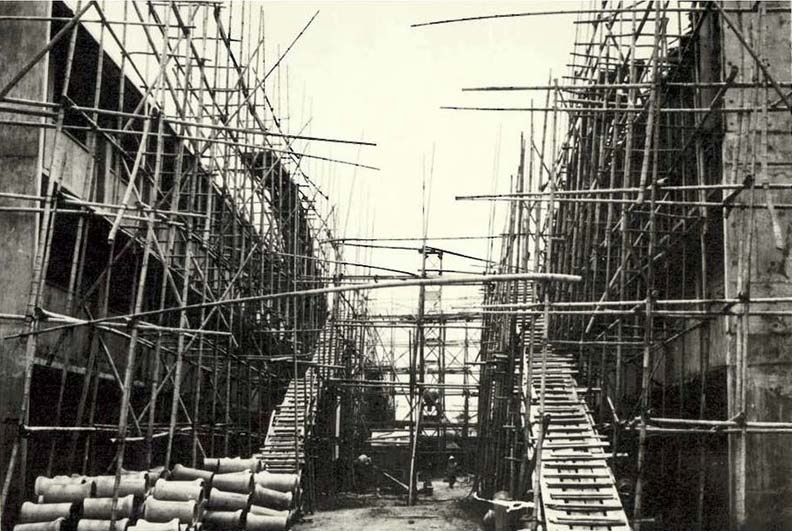
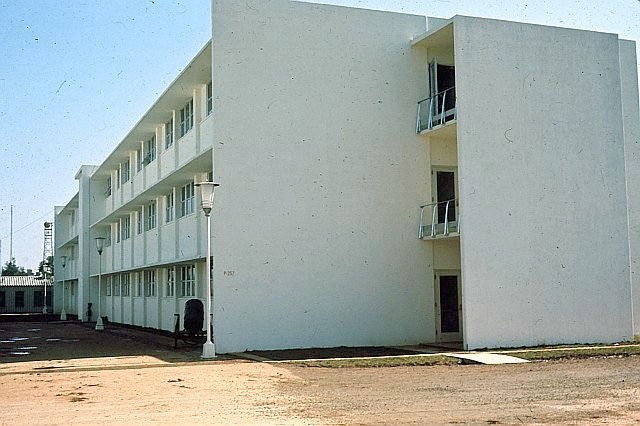
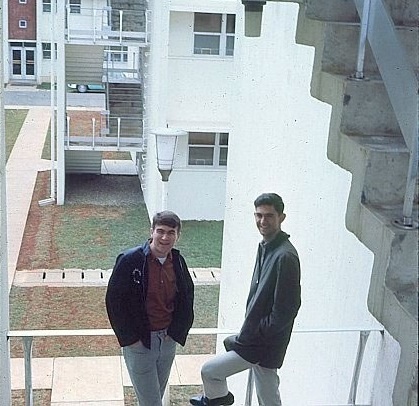
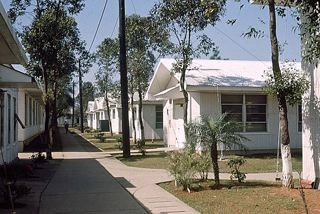
(Below left) "The Taiwan Report" (1965 edit.) provided by S. Ellinger
(Click on Photos to Enlarge)
The new barracks dormitories were started in Feb 1966 and completed in Nov 1966. The three Air Force dorms were built on the site of the old Ops Building (see photos above).
(1.-above) February 1966 start of the "200 Airmen's Dormitory" construction project on the former site of the old metal Operations Building. The four air conditioned 210-man barracks dormitories with three-man rooms were completed November 1966. In July 1965 the Service Club moved to building 132 to make way for the new Navy dormitory.
(2. and 3.) The new Air Force barracks dormitories are shown under construction in 1966. The BX is in the far left background.
(4.) November 1966 shot of the newly completed Dawg Flight barracks dorm (2nd floor) and BX (far left background).
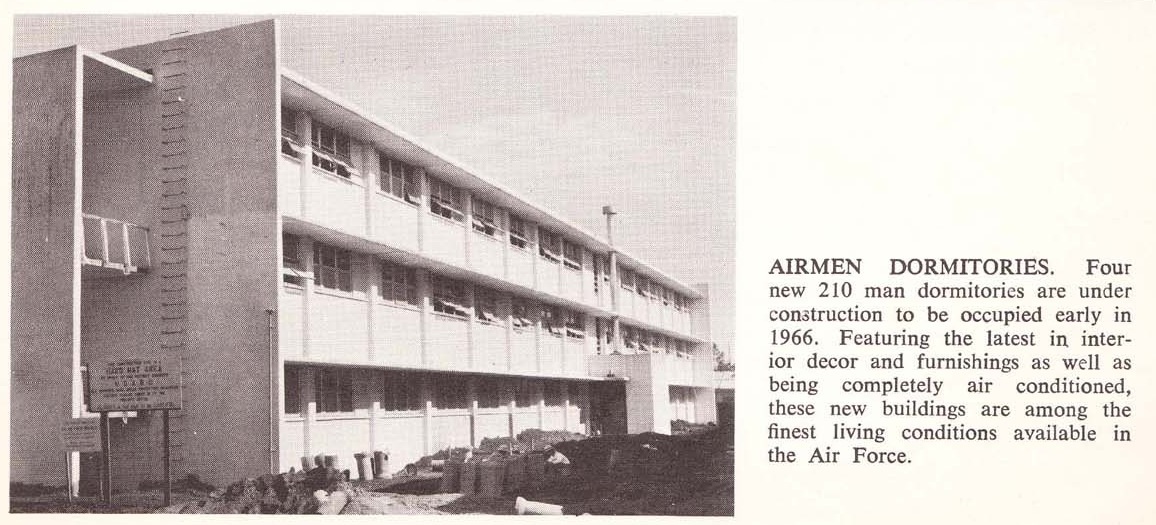
 (5.-above) November 1966 shot of Dale Warlamont (left) and "Unidentified" on the rear stairwell landing outside the just completed Dawg Flight barracks dorm. The dorms in the background are Able Flight (2nd floor) and Navy (far left). The BX is off to the left. (Note the new grass growing around the brand new dorms.)
(5.-above) November 1966 shot of Dale Warlamont (left) and "Unidentified" on the rear stairwell landing outside the just completed Dawg Flight barracks dorm. The dorms in the background are Able Flight (2nd floor) and Navy (far left). The BX is off to the left. (Note the new grass growing around the brand new dorms.)
(6.) Summer 1966 shot of Dawg Flight's old metal, open-bay barracks prior to moving to the new dorms Nov 1966.
(Left Photo-Click to Enlarge) Partially completed dormitory in 1966. The sign (far left) reads: "Hard Hat Area".
(Right Photo) Summer 1966 aerial shot showing two completed Air Force dormitories with the third under construction, and the Navy dorm (to the left).
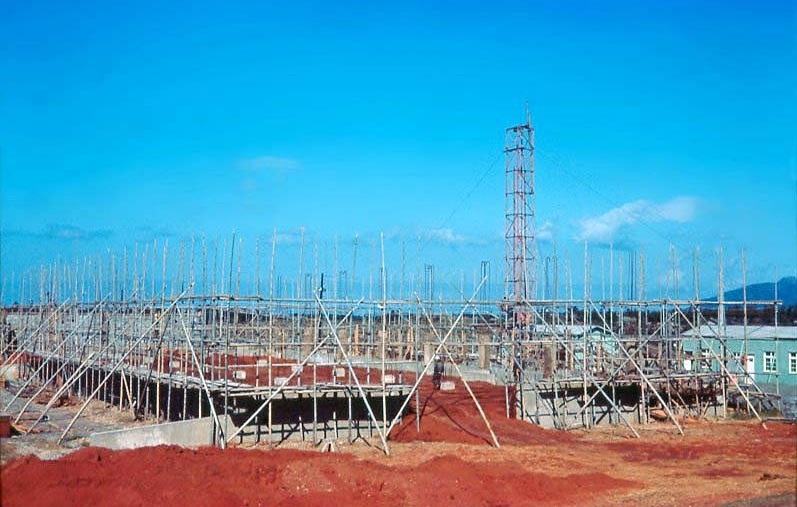
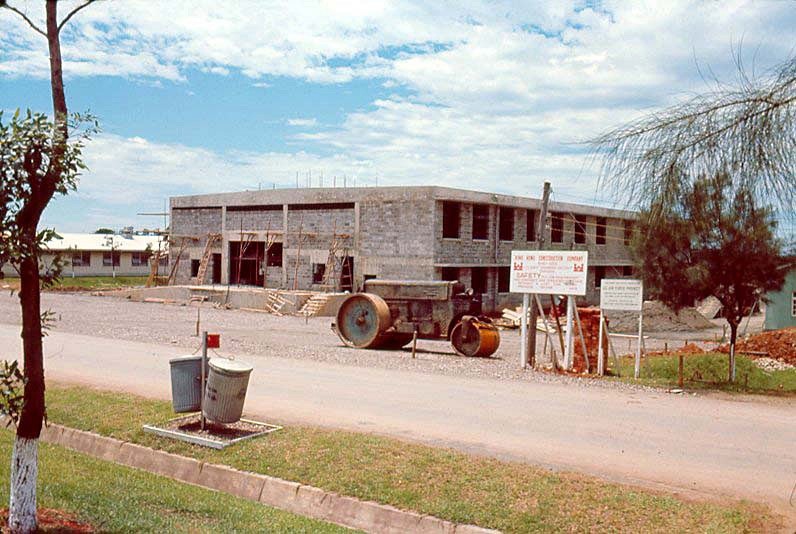
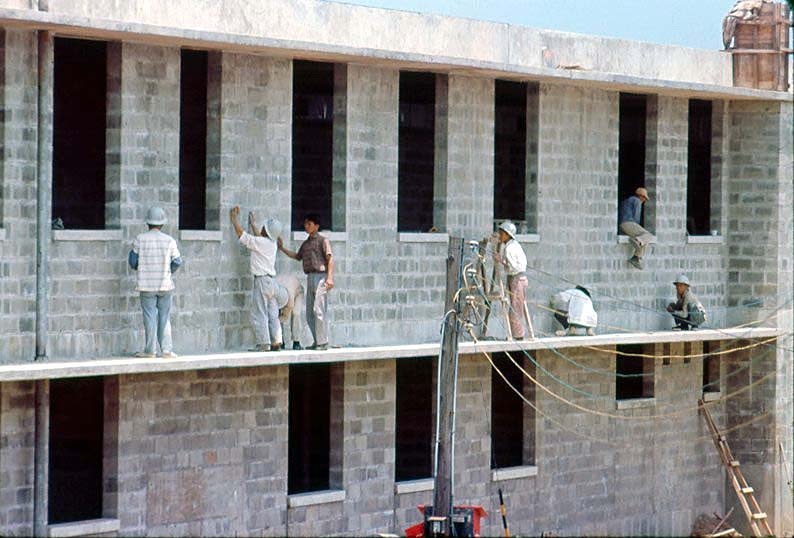
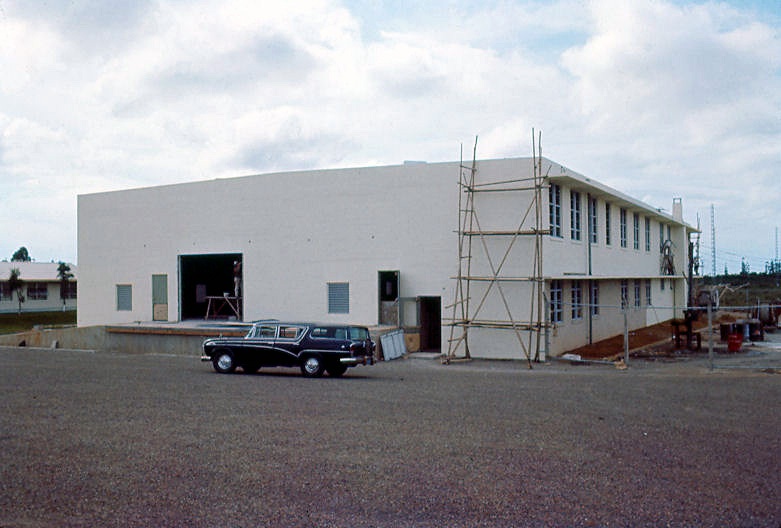
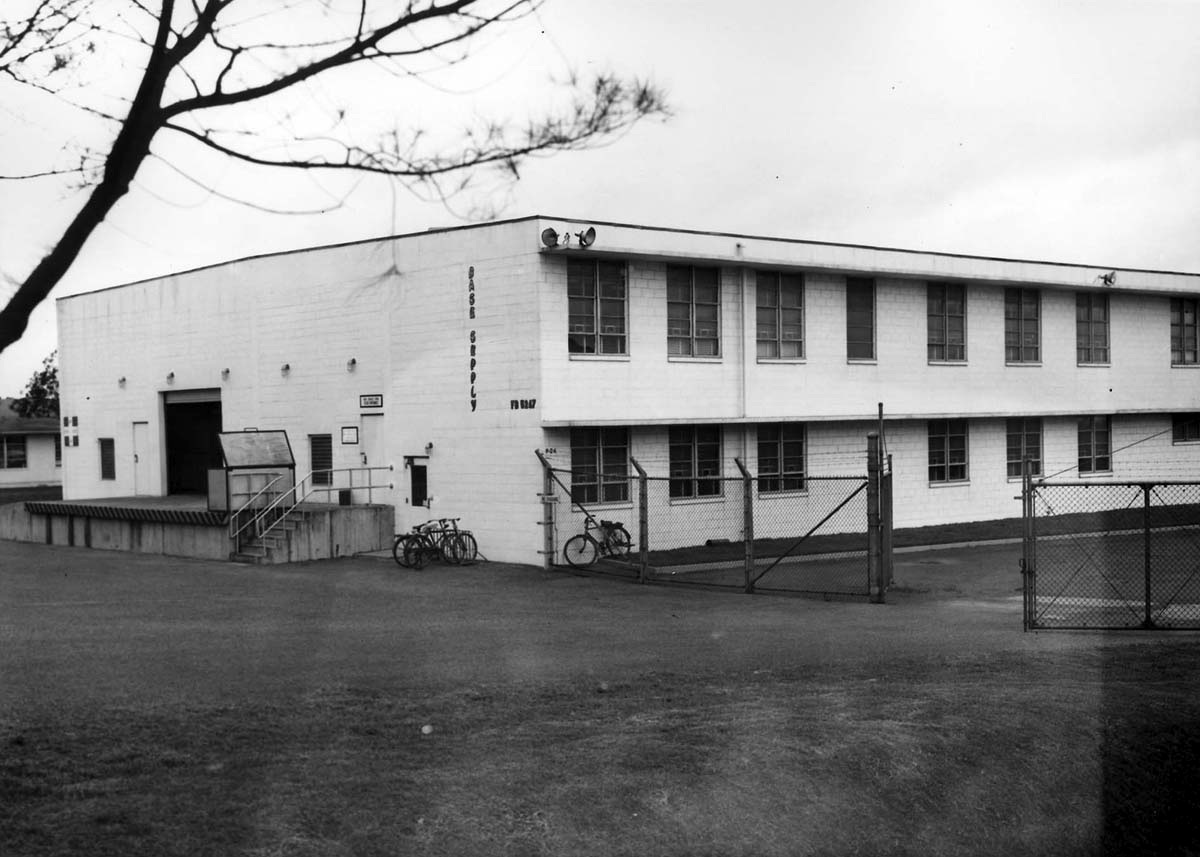
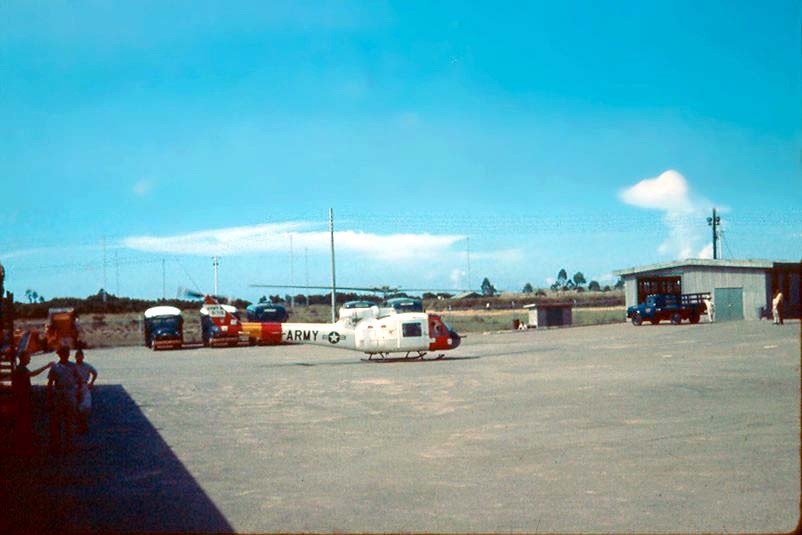 (1.) The start of the Supply Warehouse construction project in 1964. The construction site was located next to the Motor Pool (two green buildings visible on far right).
(1.) The start of the Supply Warehouse construction project in 1964. The construction site was located next to the Motor Pool (two green buildings visible on far right).
(2.) The Supply Warehouse building near completion in 1965. The old corrugated metal, open-bay NCO Barracks building is on the far left and the Motor Pool is visible on the far right (green building).
(3.) Taiwanese construction workers putting the finishing touches on the Supply Warehouse exterior. The Supply Warehouse completed in 1965 and the Operations Center completed in 1964 were the first concrete structures built on base.
(4.) Nearly completed Supply Warehouse in 1965. Parked in front of the building is a 1956 Nash Rambler, Custom Cross Country Station Wagon. The old NCO Barracks are on the far left.
(5.) 1969 shot of the Base Supply Warehouse. The Electronic Hobby Shop (formerly the open-bay NCO Barracks) is on the far left.
(Right Photo) 1964 shot of the Motor Pool, also utilized as the base helipad. The Supply Warehouse construction site was located just off to the left of the photo, adjacent to the Motor Pool (ref. base map-top of page).
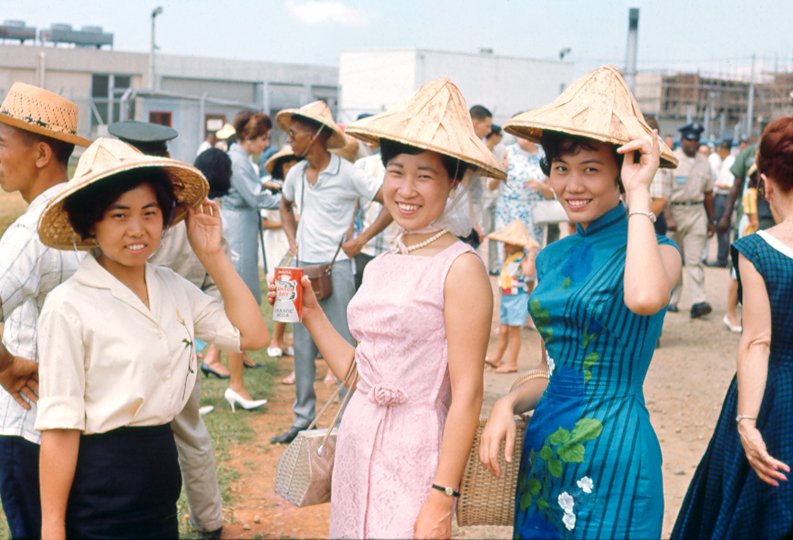
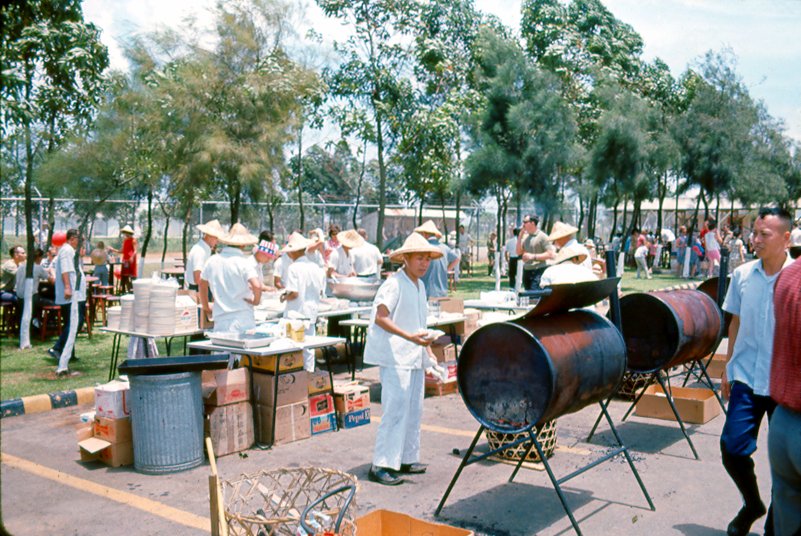
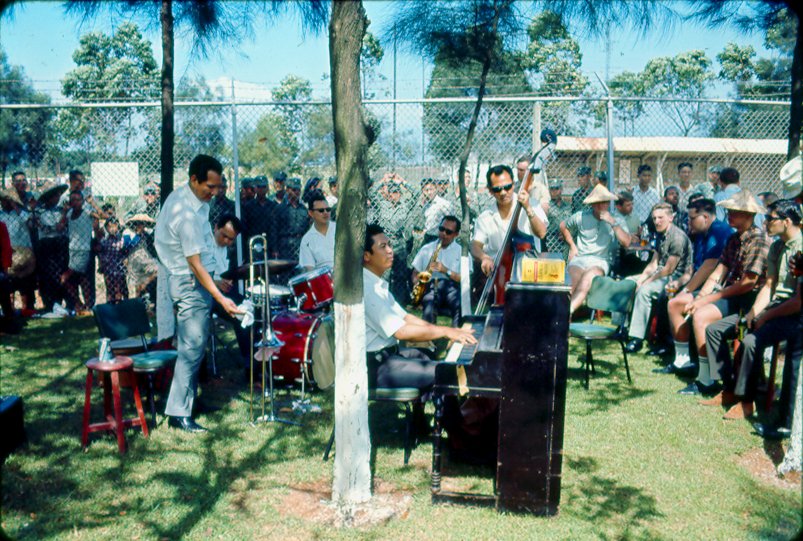
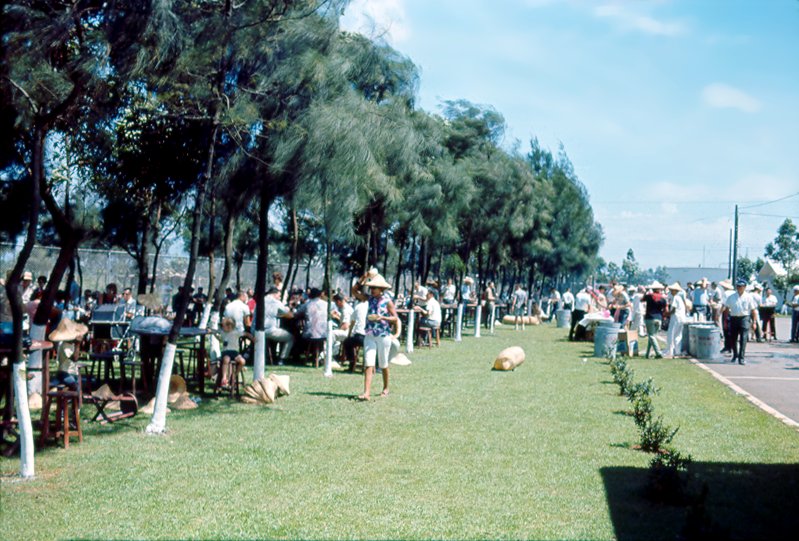
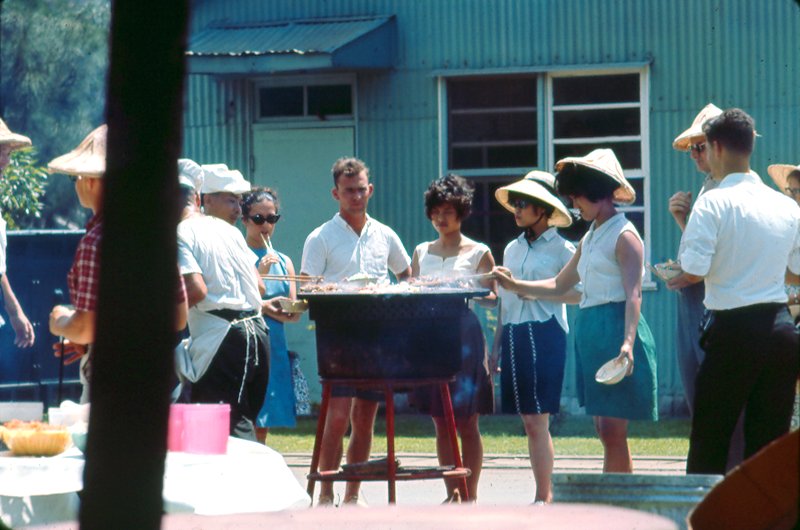
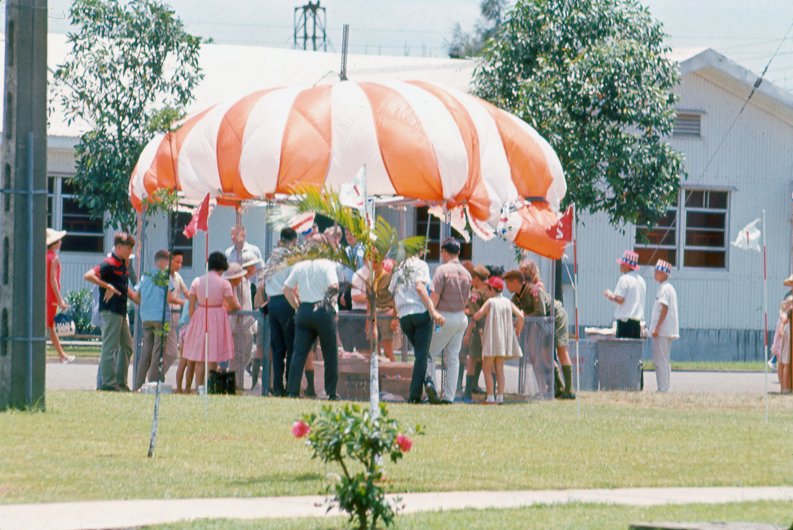

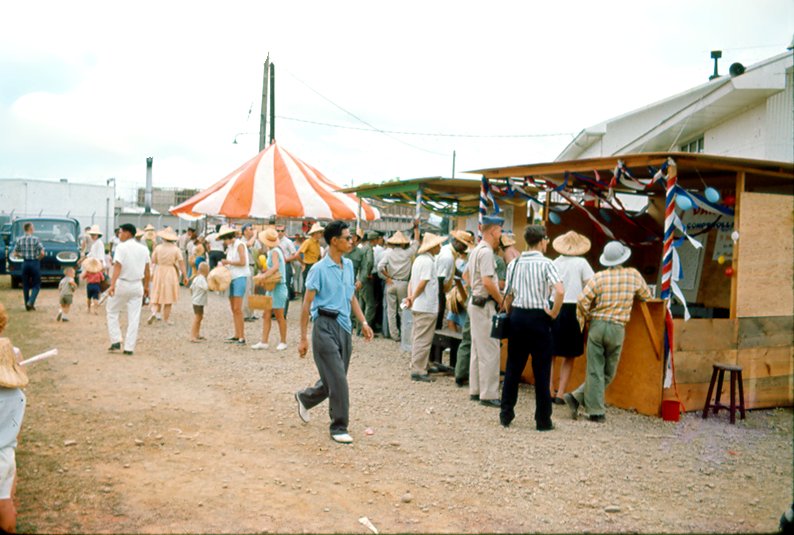
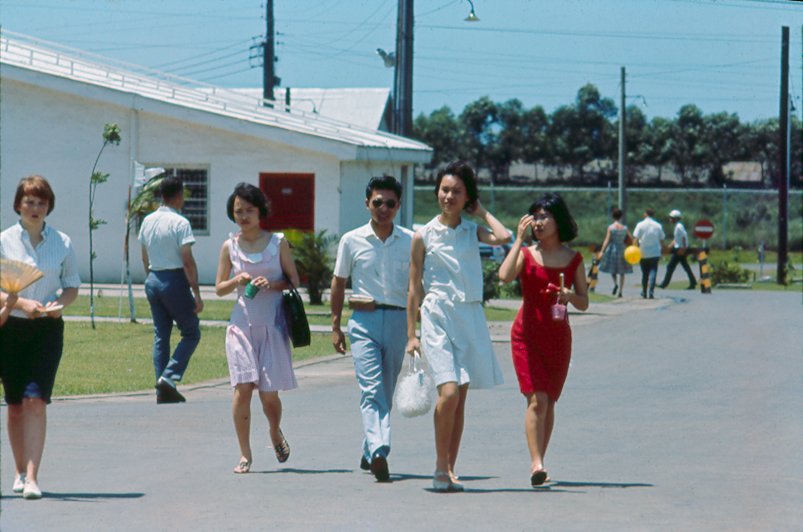
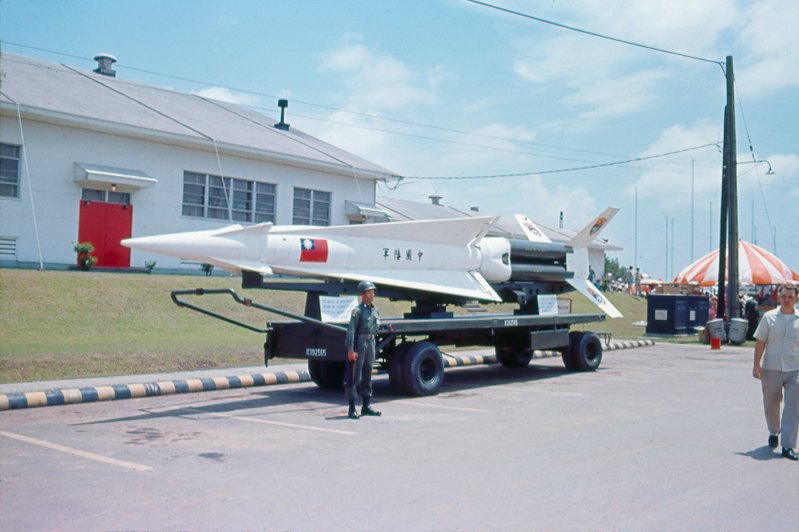
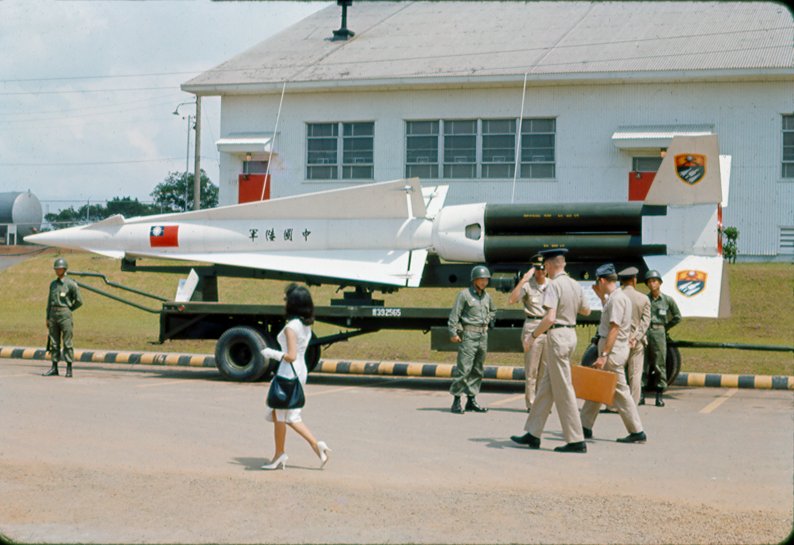
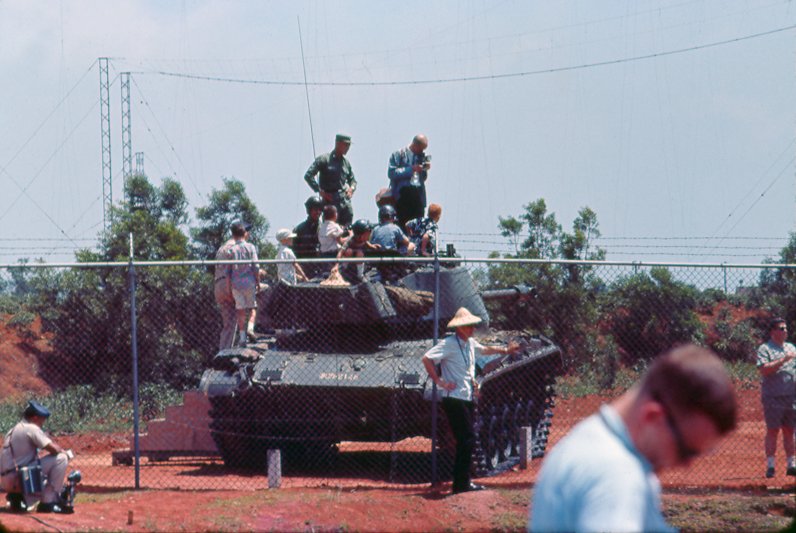
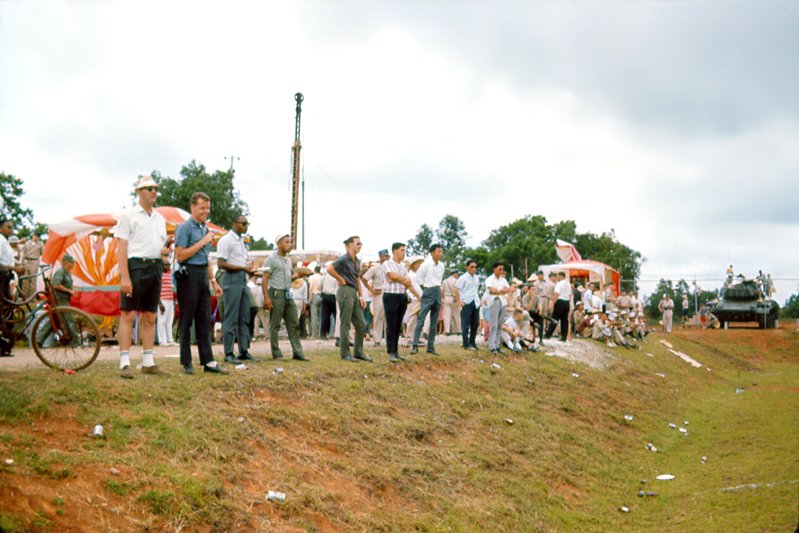
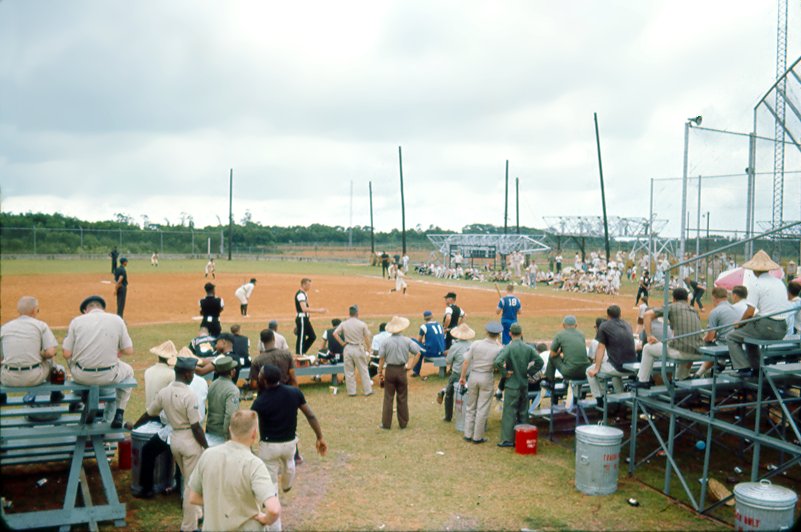
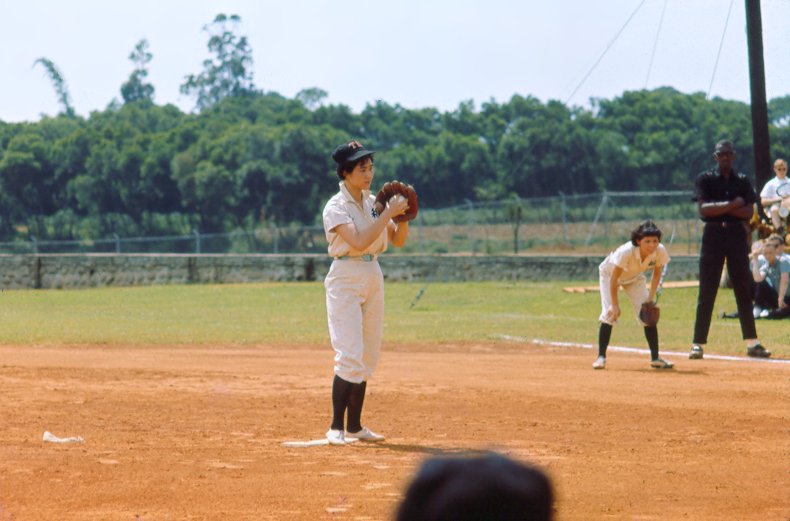
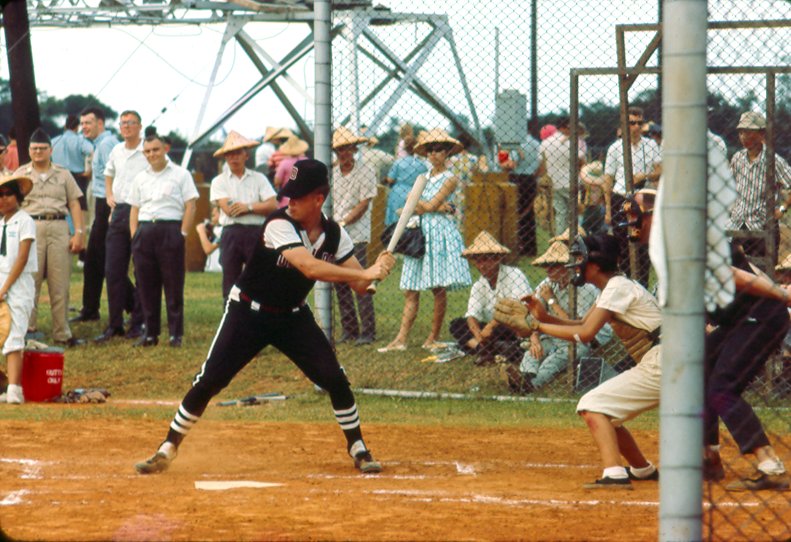
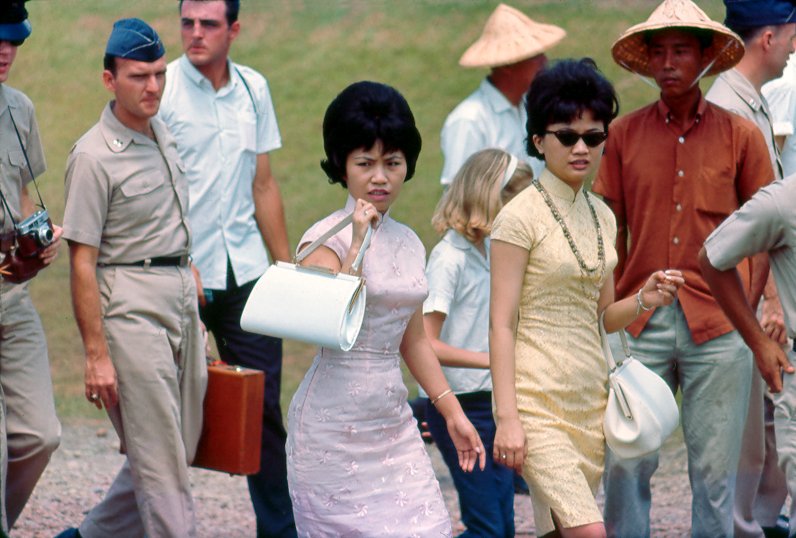
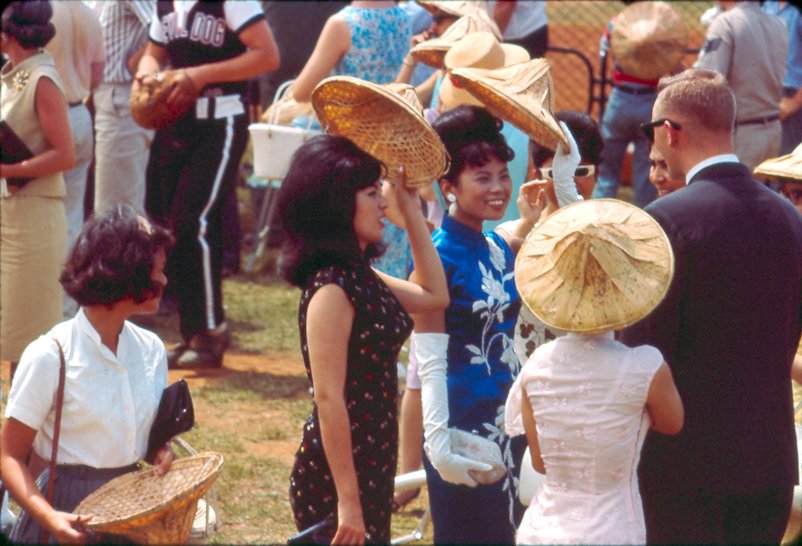
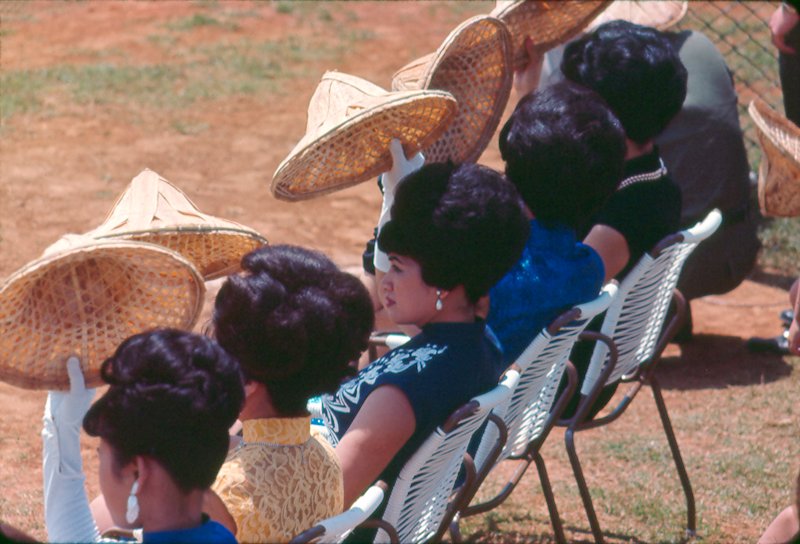
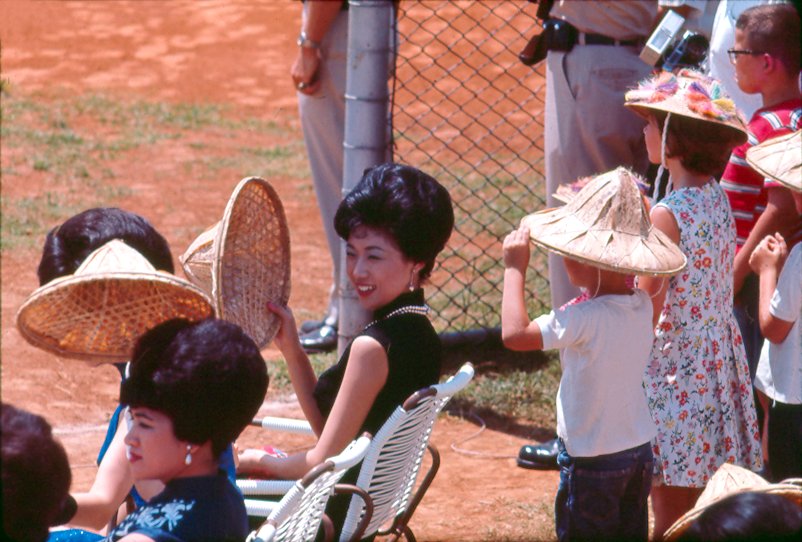
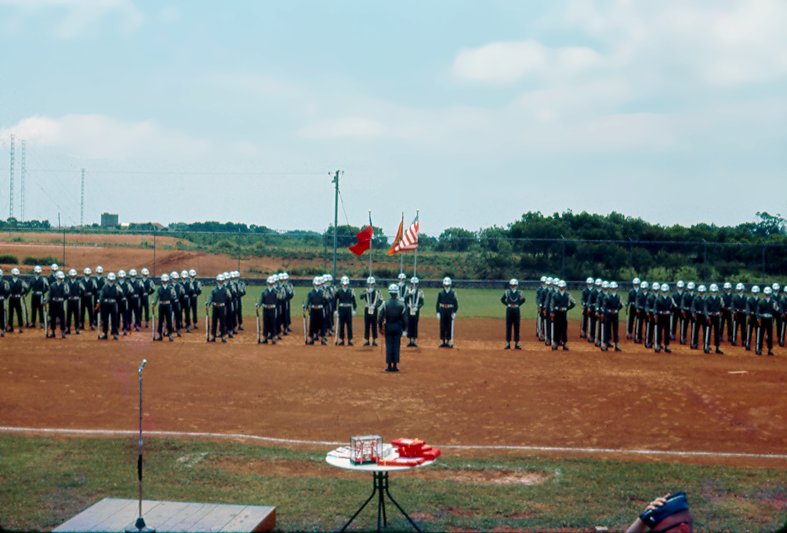
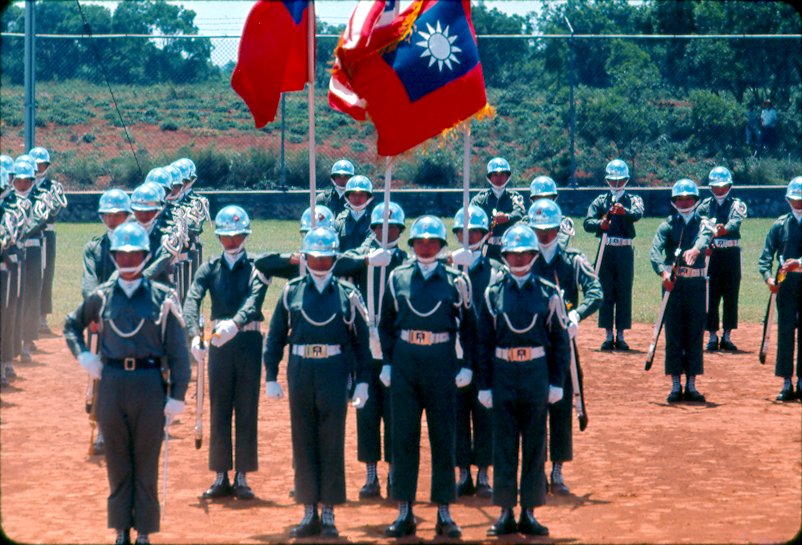
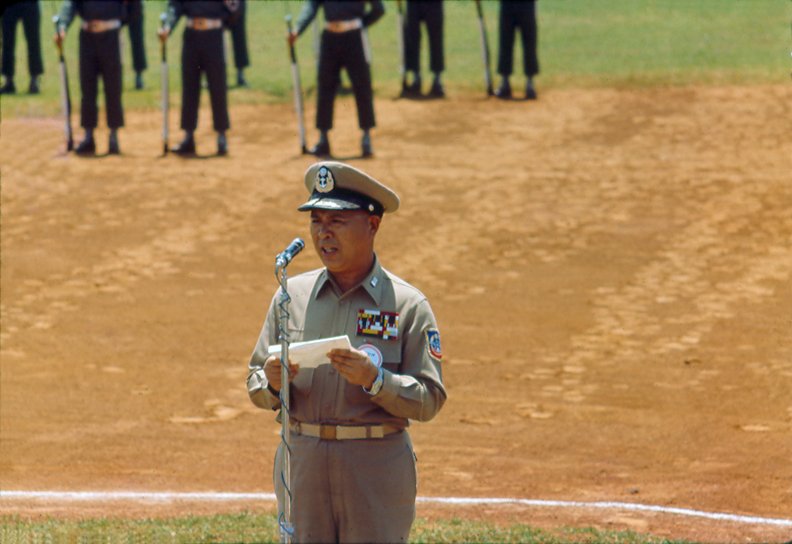
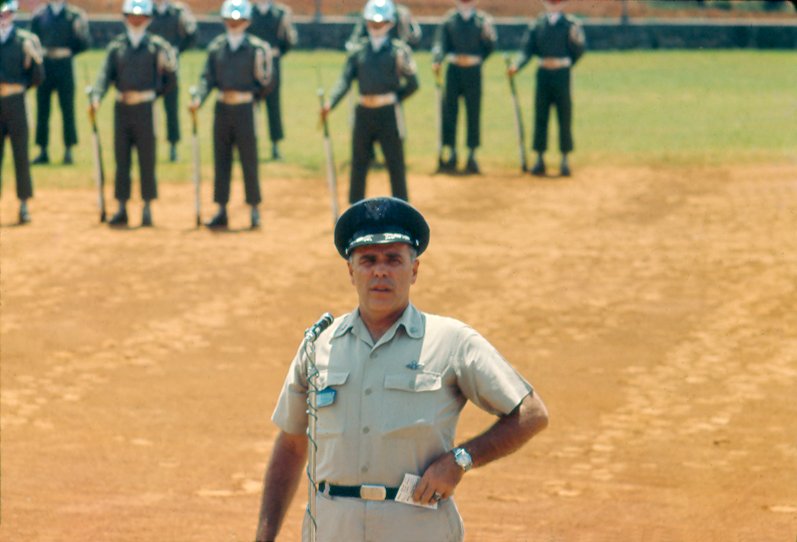
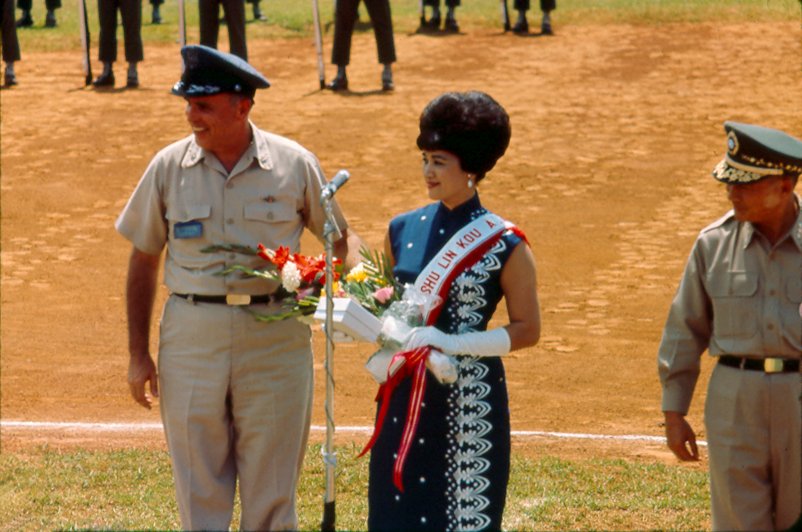
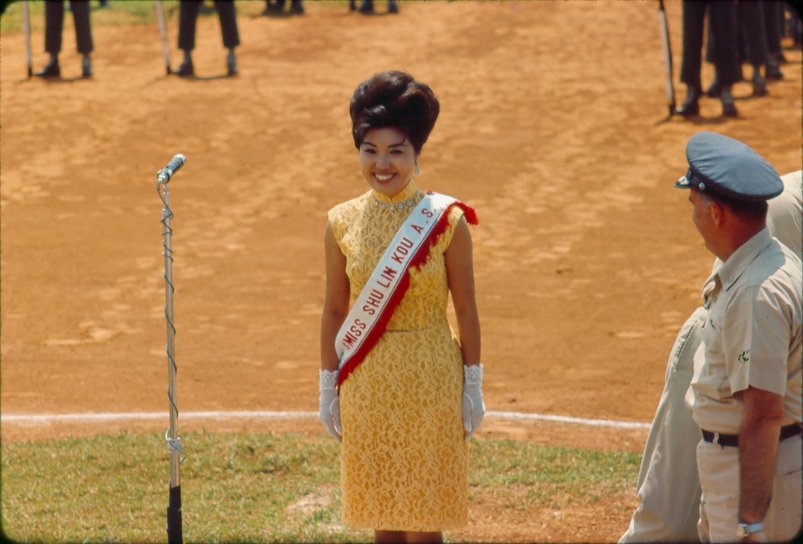

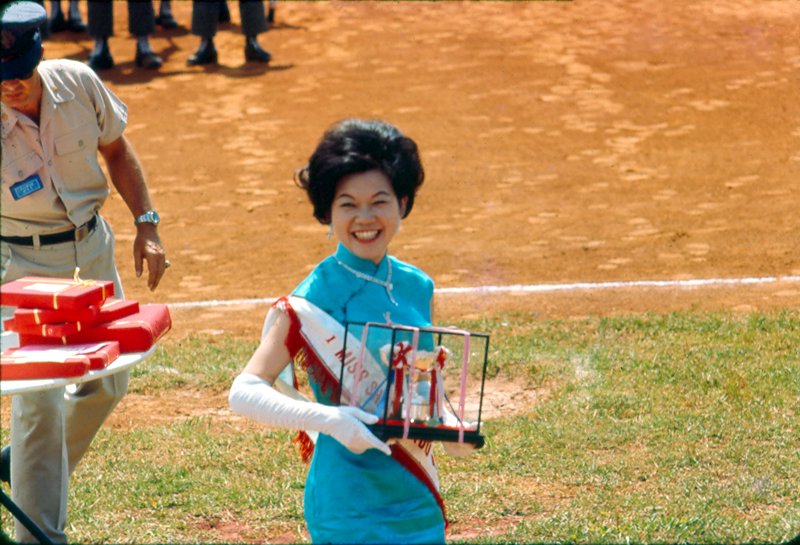

(Click on Photo to Enlarge)
"Miss Shu Lin Kou" is honored at the Linkou Officers' Club after the
awards ceremony as part of the 1965 10th anniversary celebration.
|
|